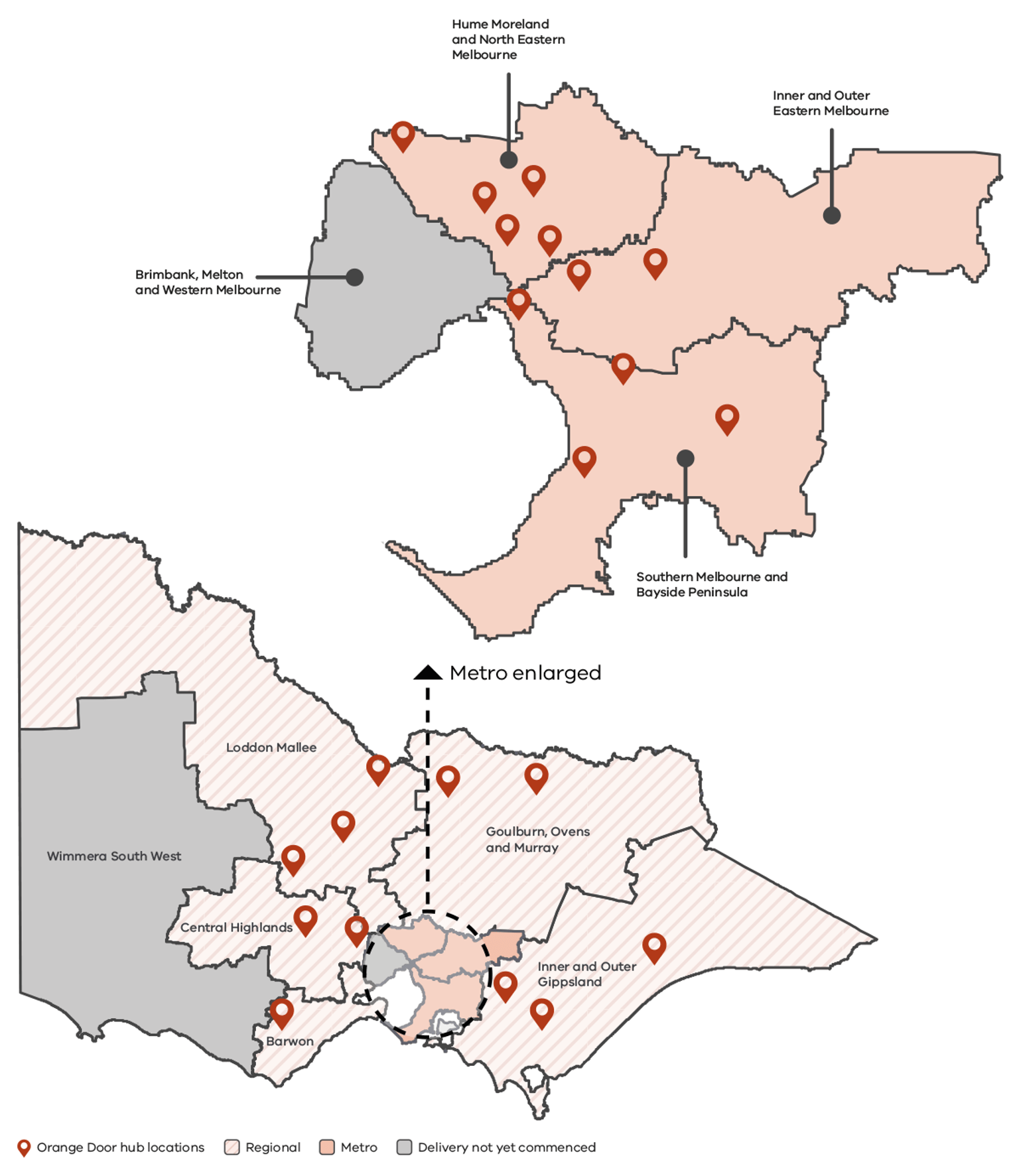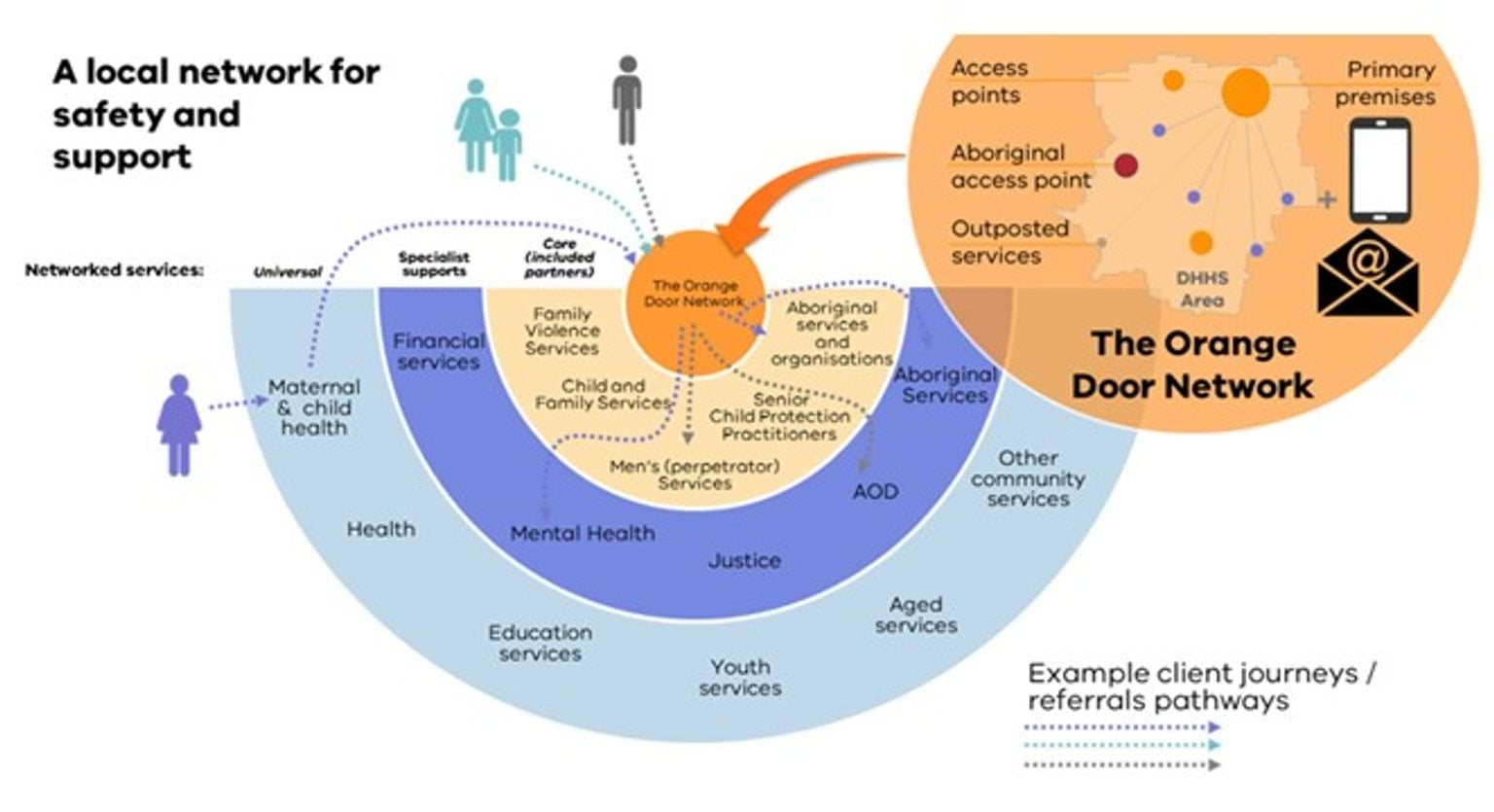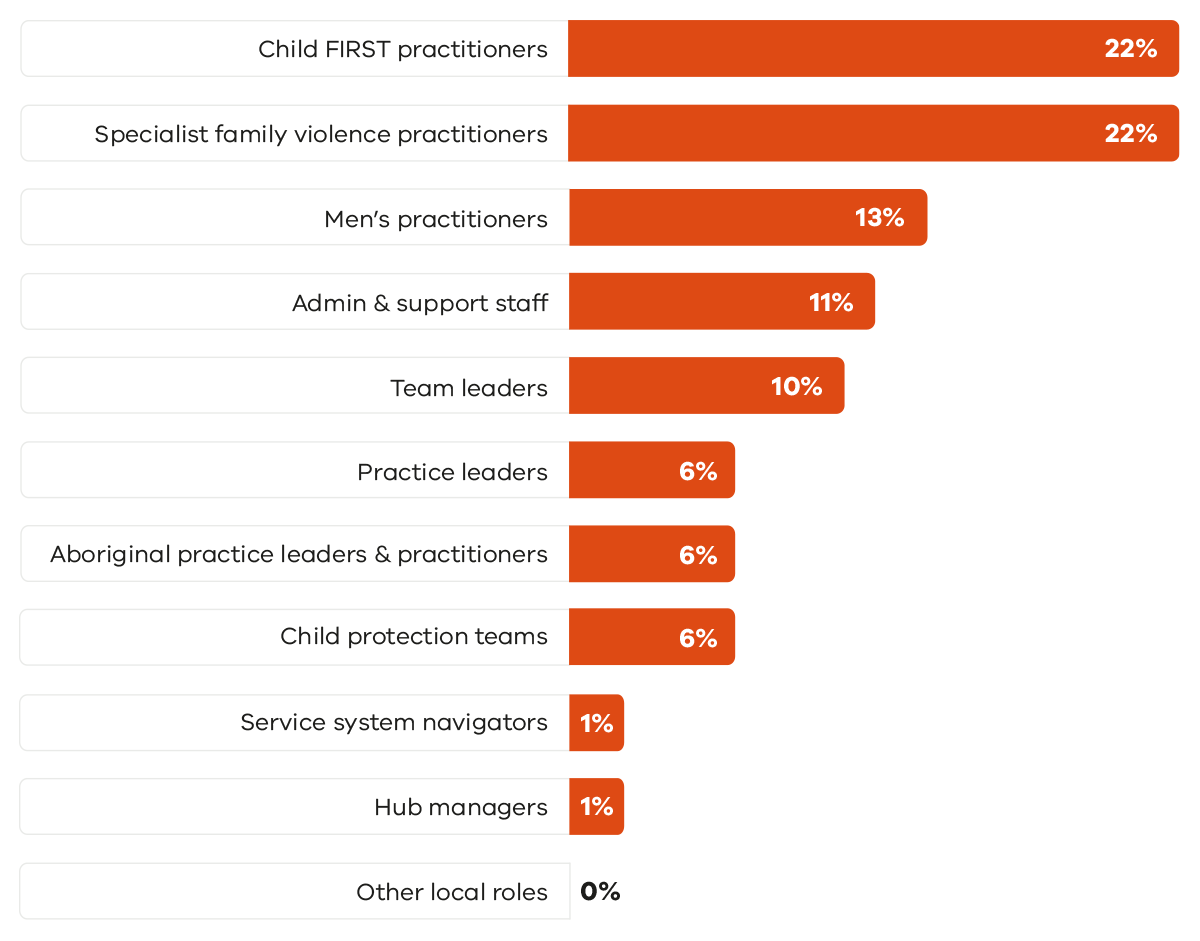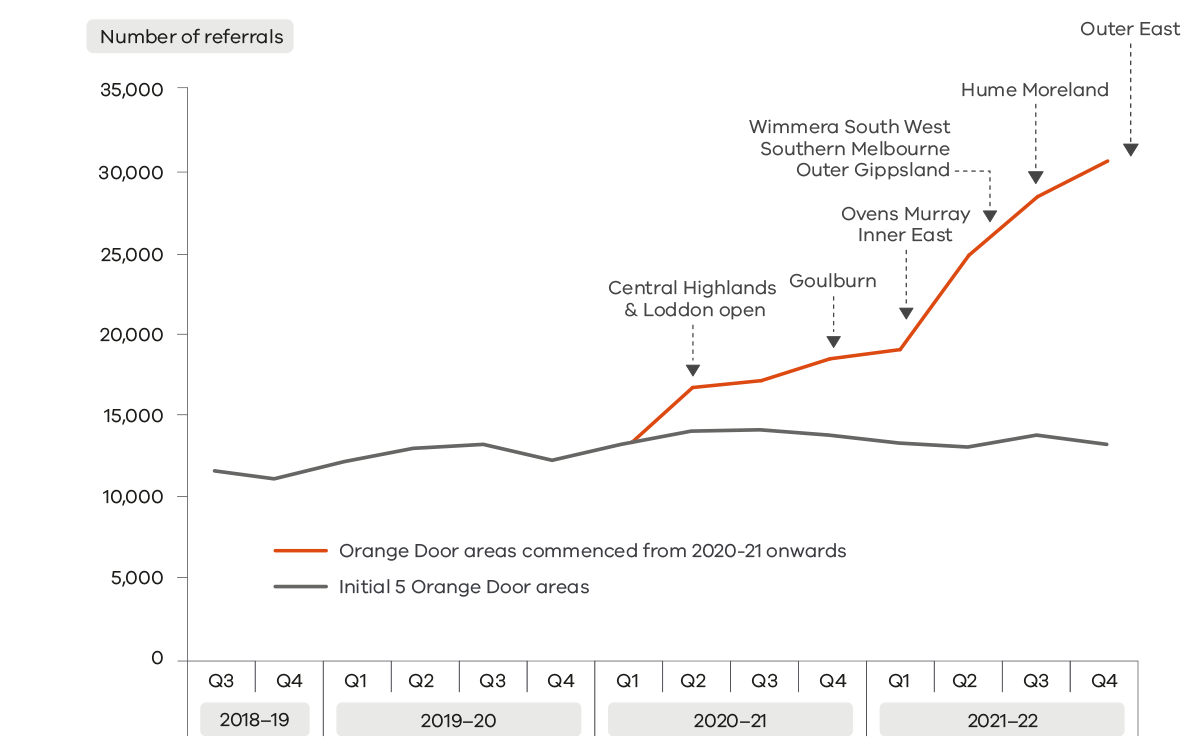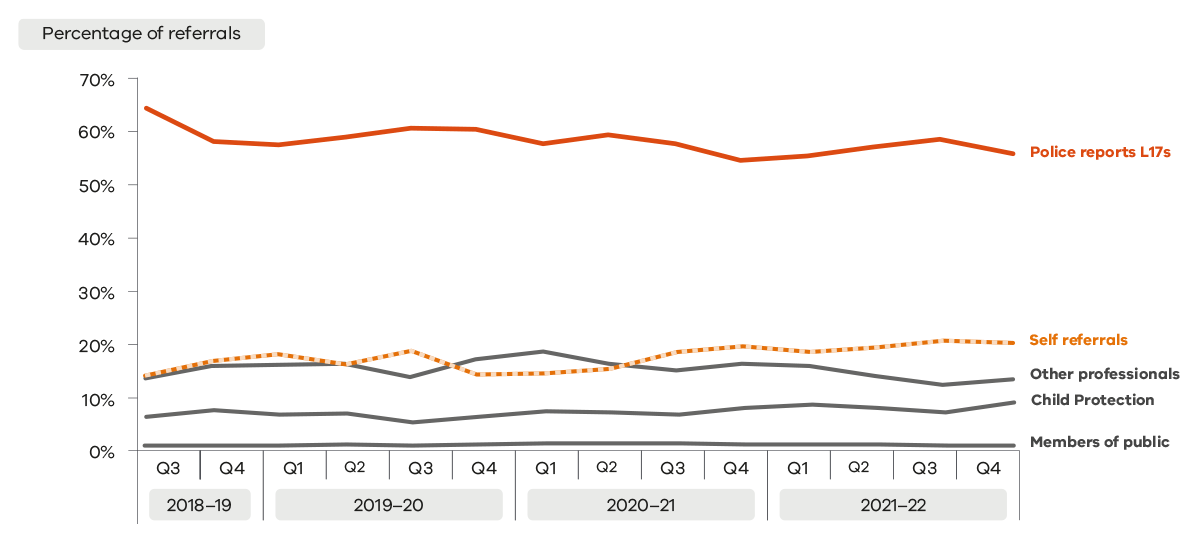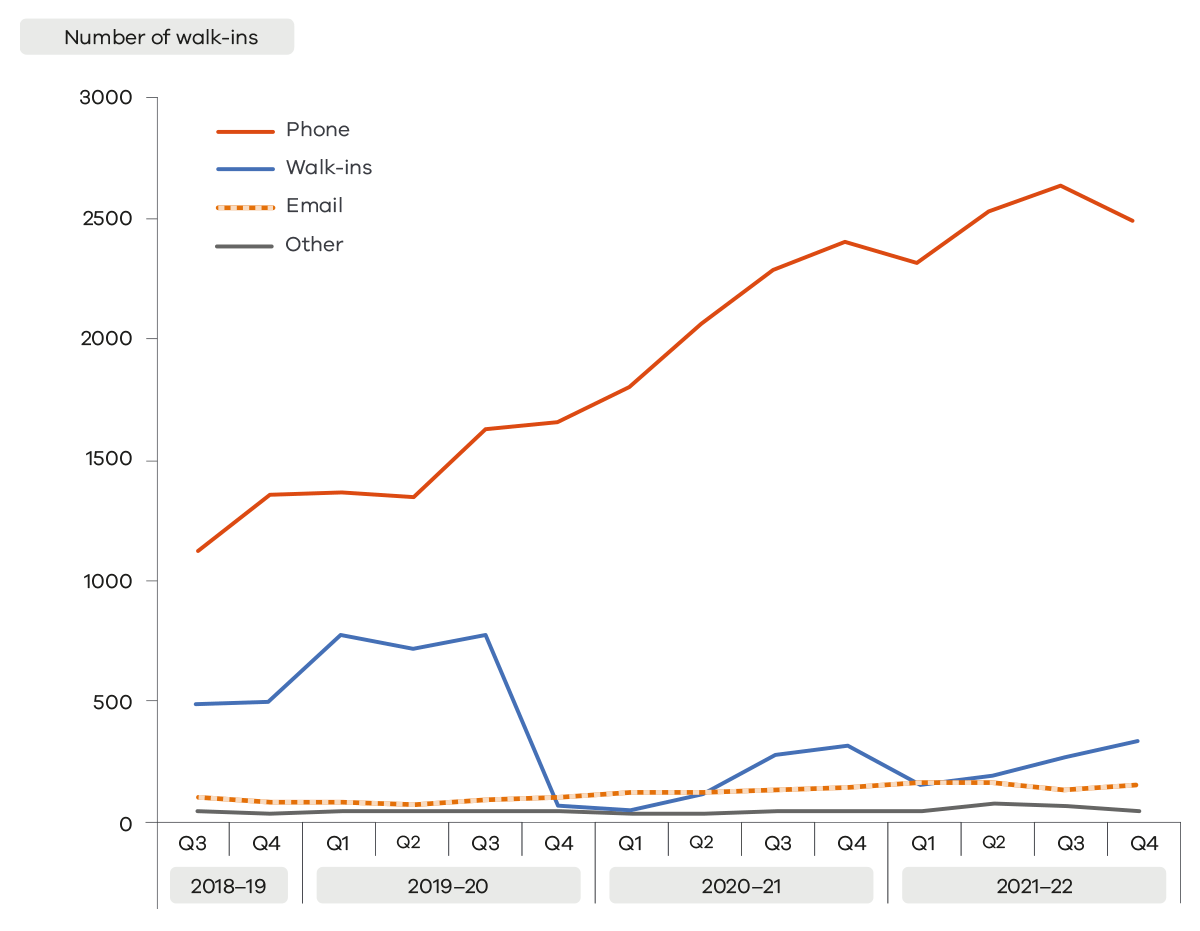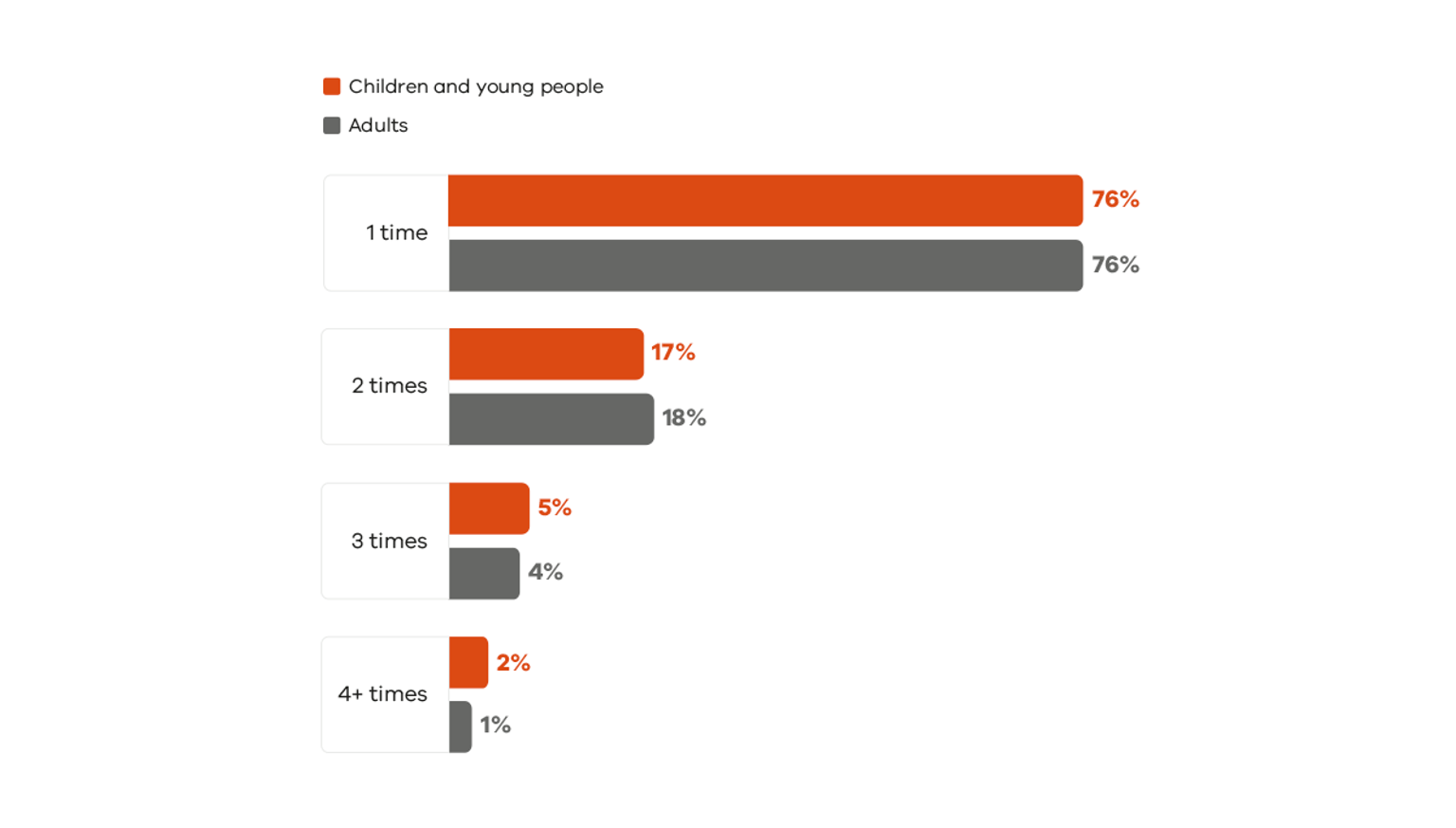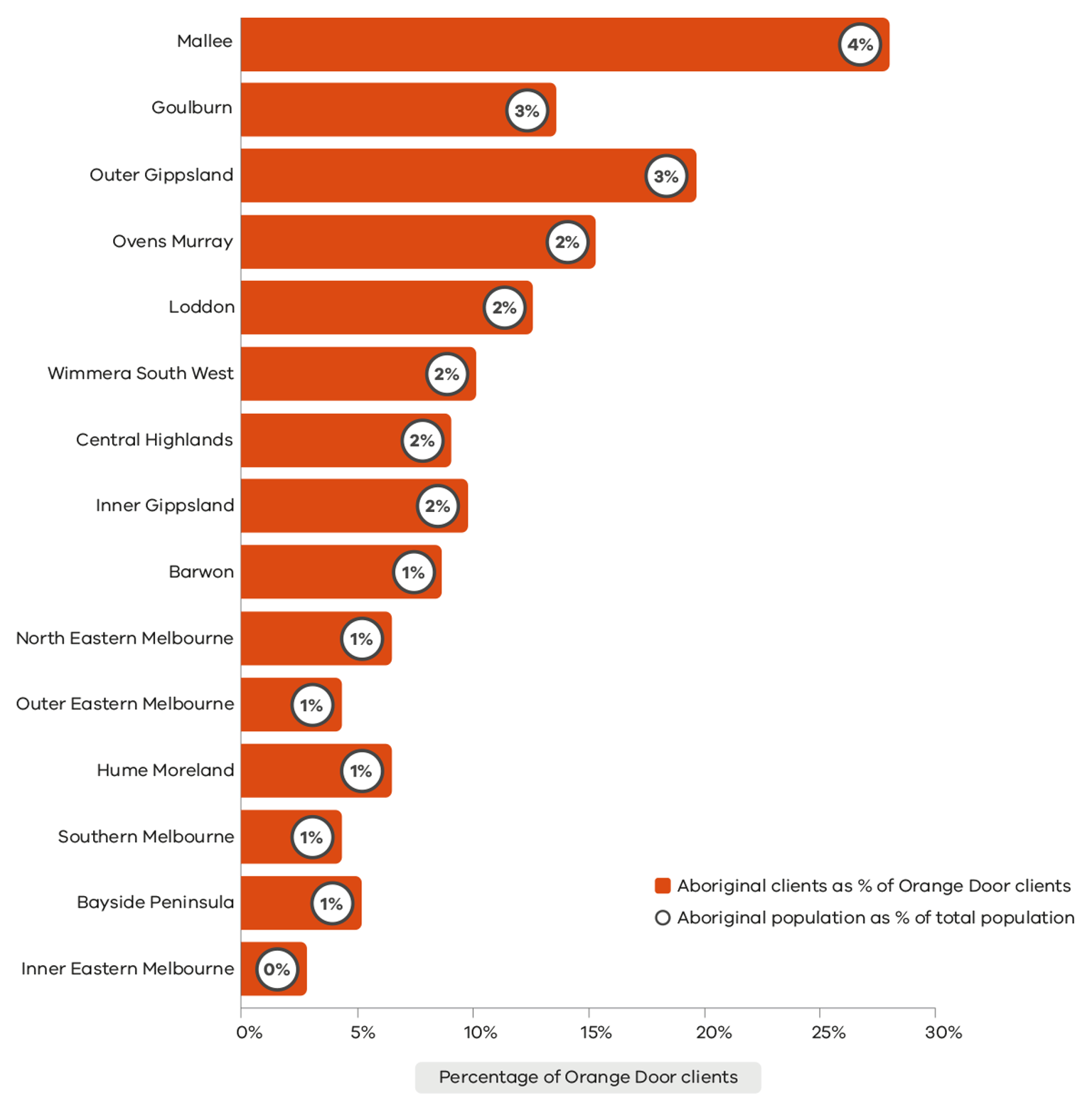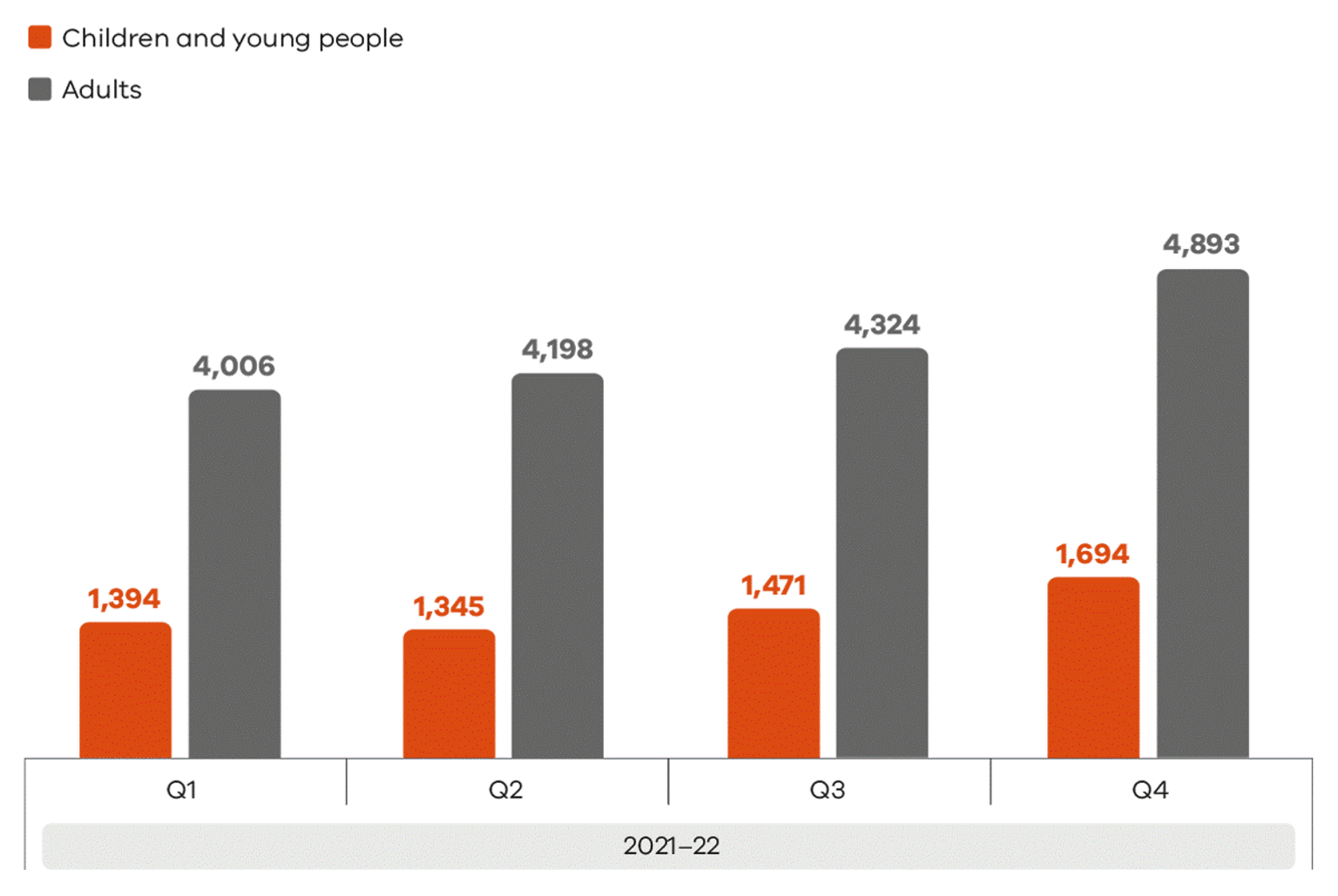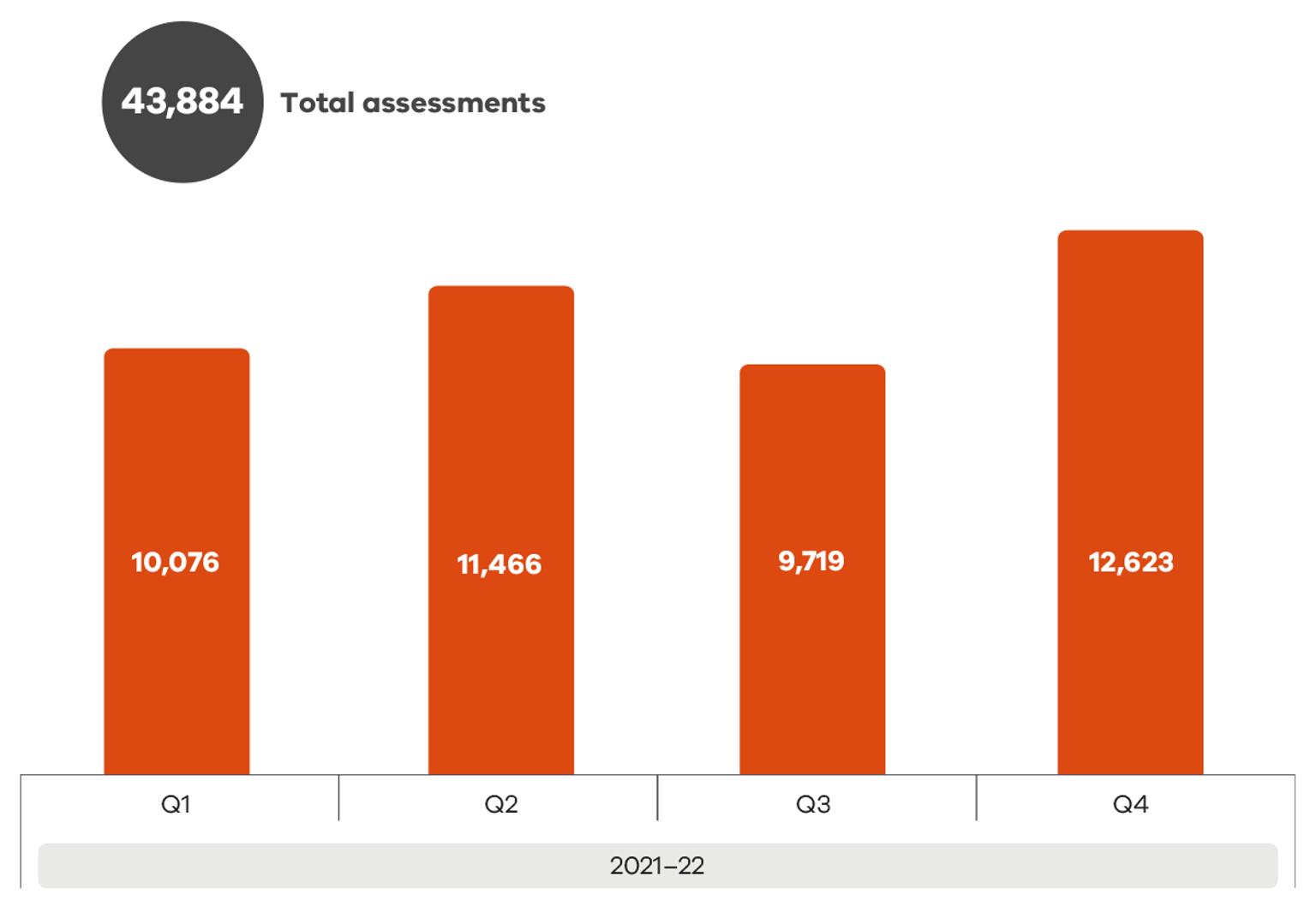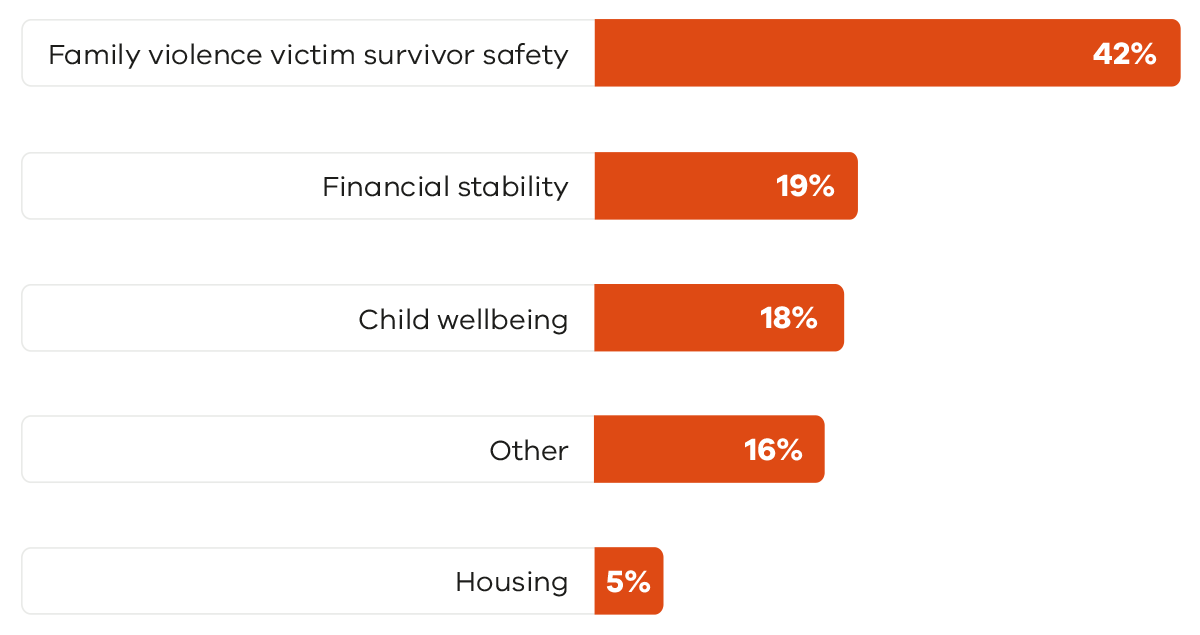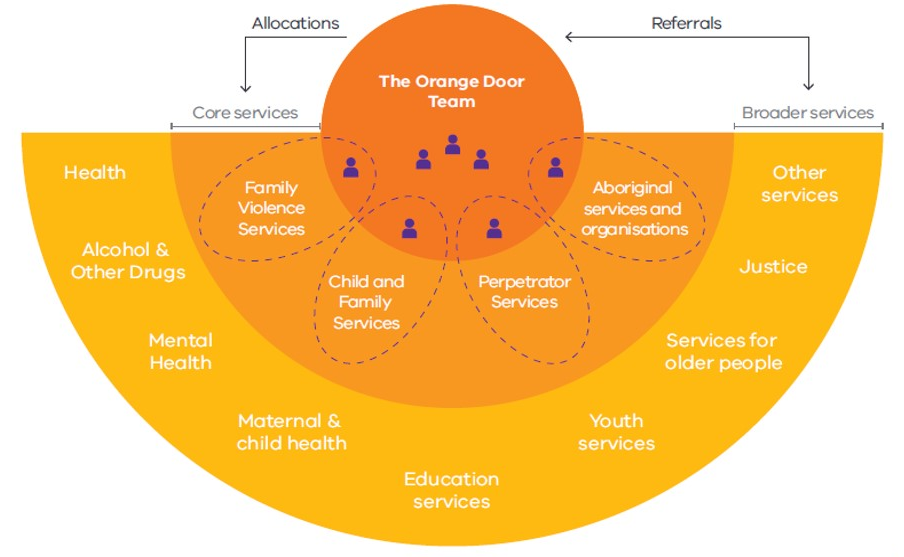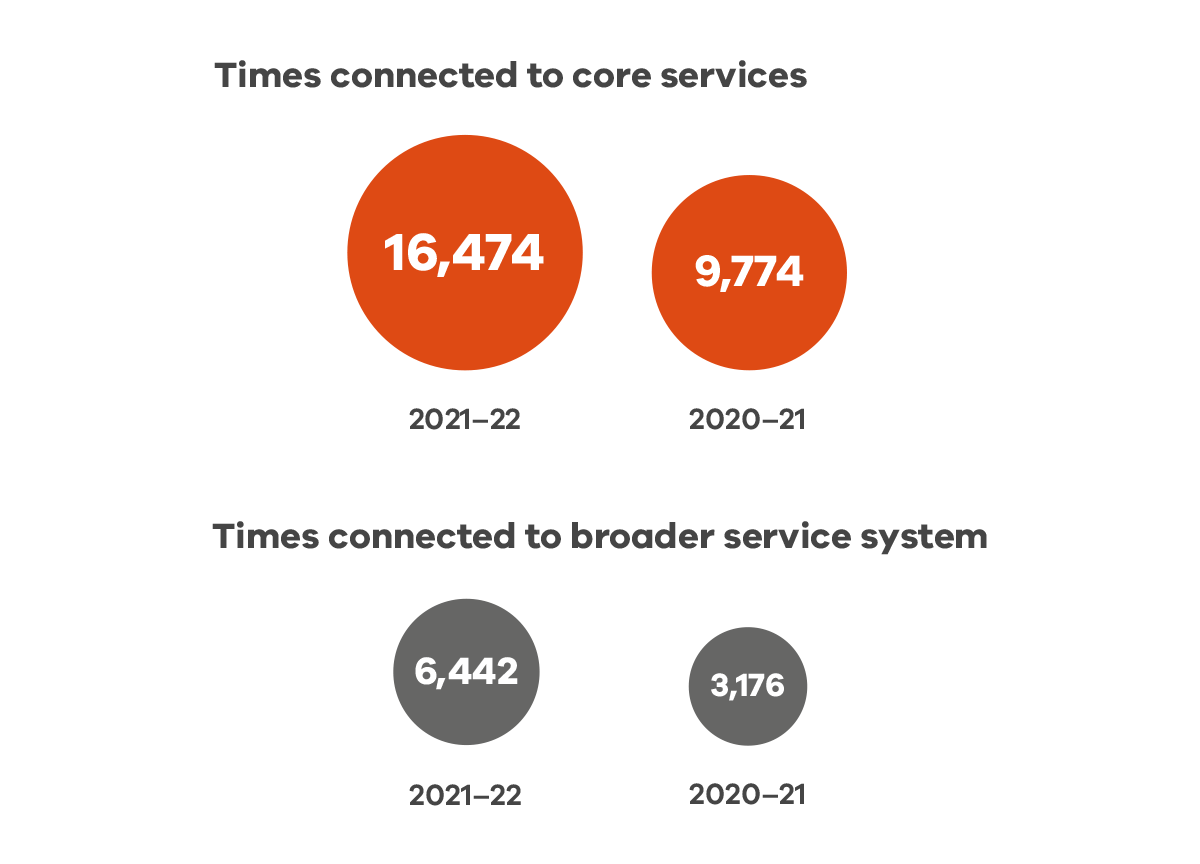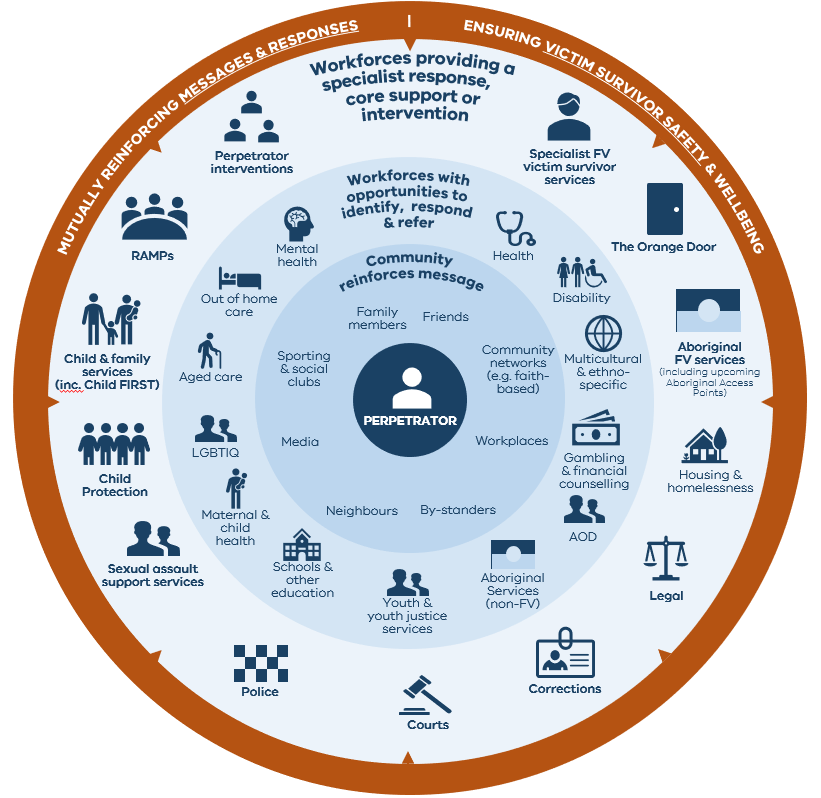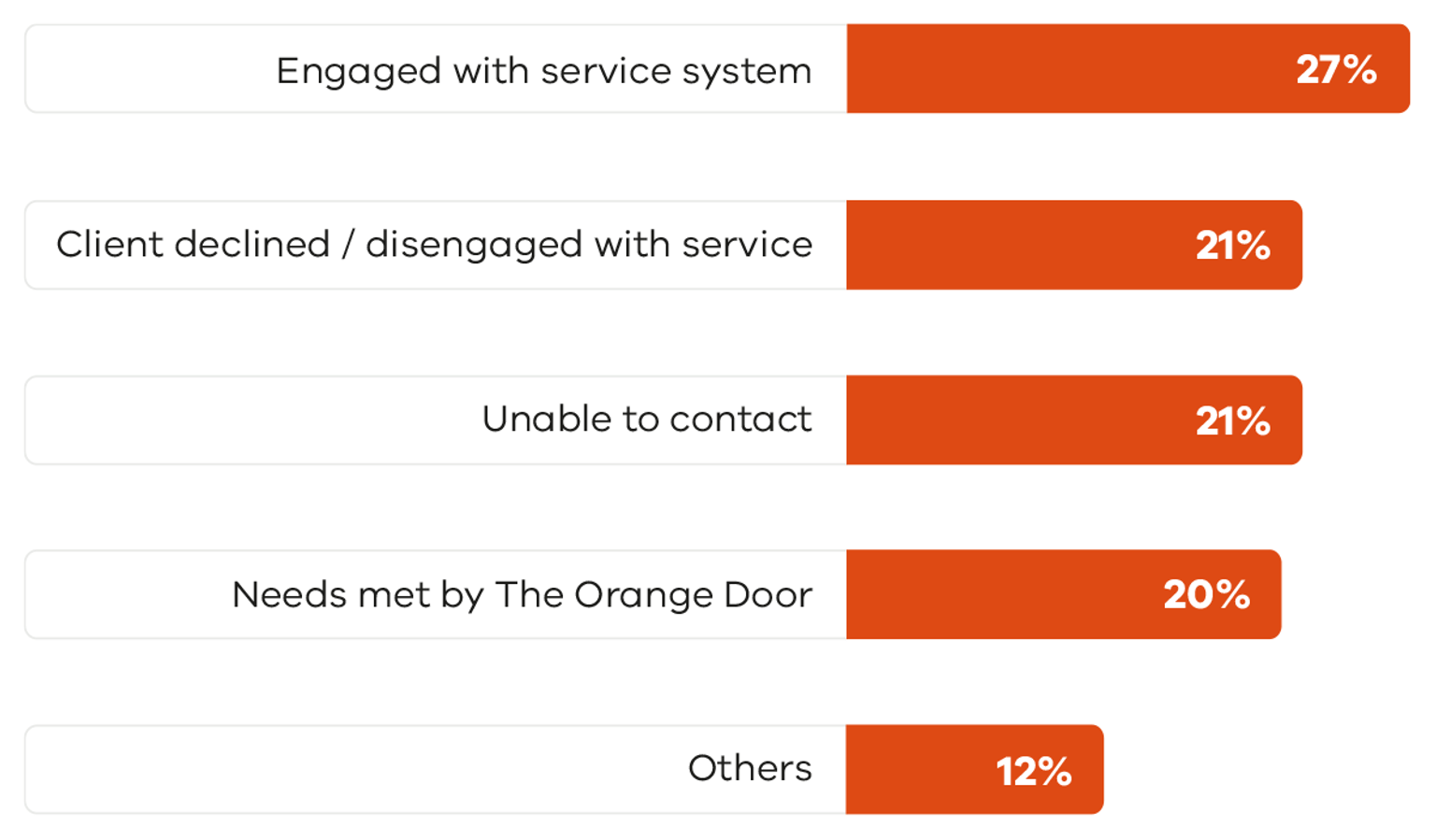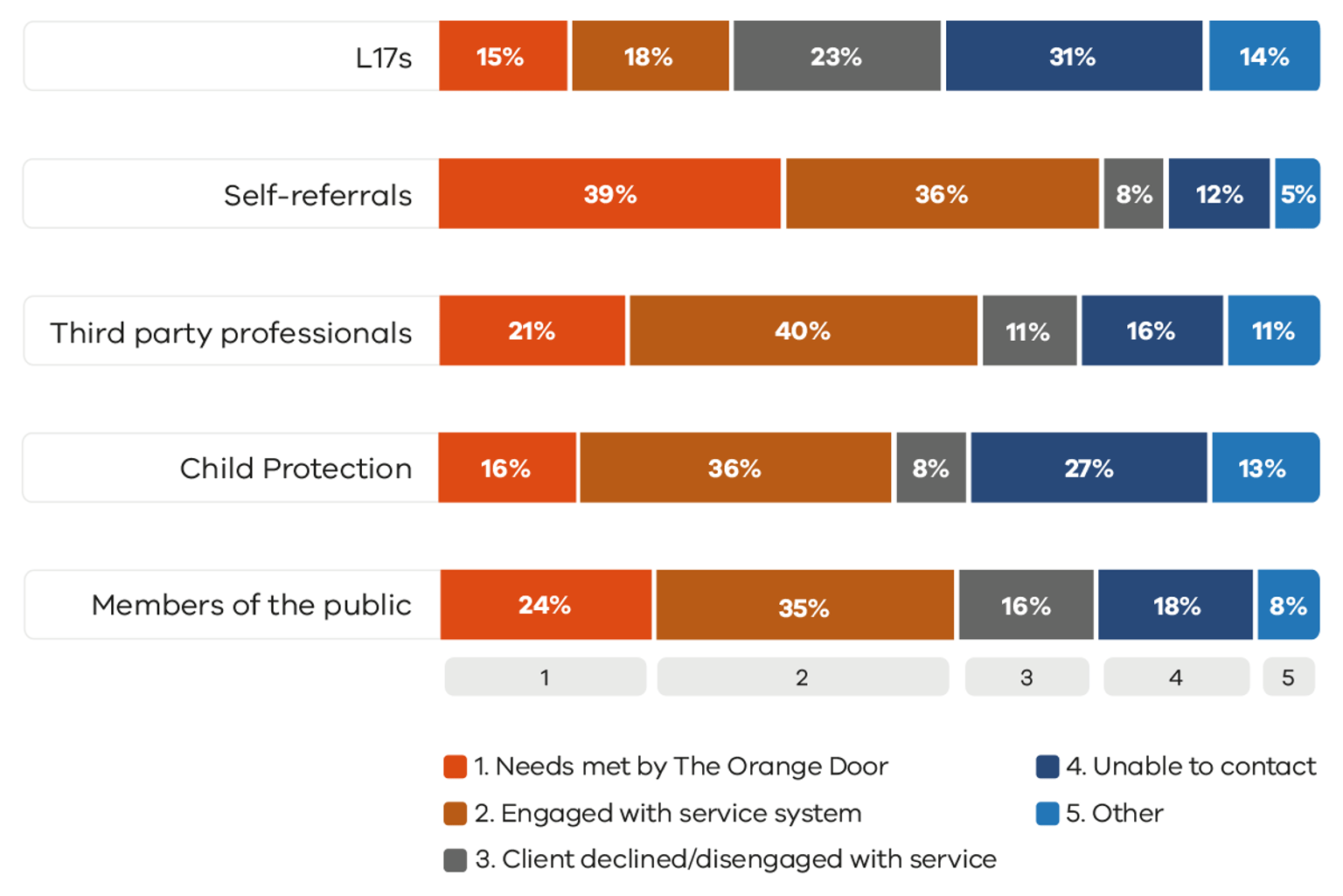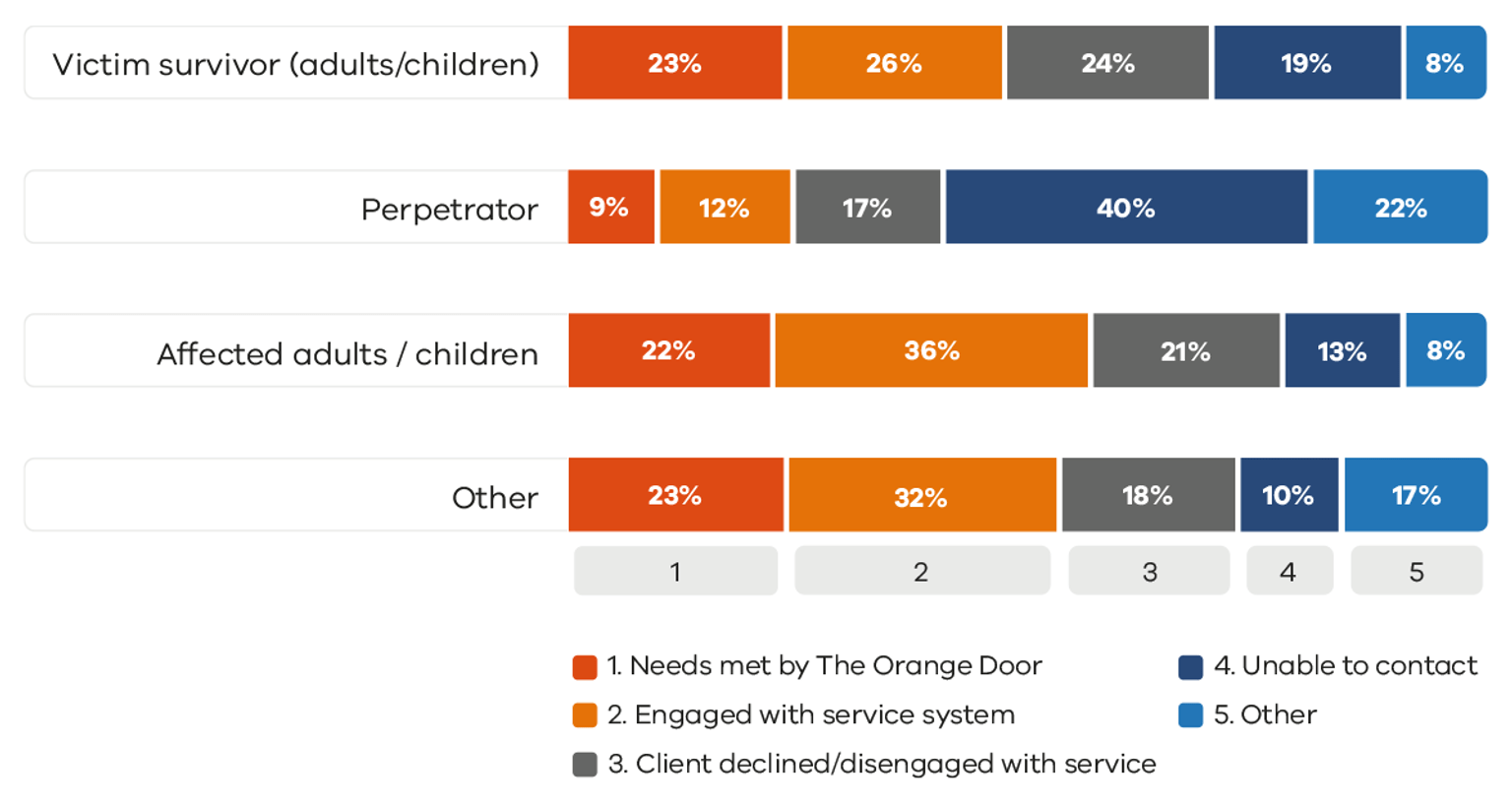- Published by:
- Family Safety Victoria
- Date:
- 5 May 2023
To receive this document in another format, phone 03 9085 0900, using the National Relay Service 13 36 77 if required, or email reception@familysafety.vic.gov.au
Aboriginal acknowledgment
The Victorian Government proudly acknowledges Victorian Aboriginal people as the First Peoples and Traditional Owners and custodians of the land and water on which we rely.
We acknowledge and respect that Aboriginal communities are steeped in traditions and customs built on an incredibly disciplined social and cultural order. This social and cultural order has sustained up to 50,000 years of existence.
We acknowledge the ongoing leadership role of the Aboriginal community in addressing and preventing family violence and join with our First Peoples to eliminate family violence from all communities.
Foreword
Foreword from the Chief Executive Officer
This 2021-22 Annual Report covers another important operational period in the delivery of family violence reform across Victoria, with The Orange Door network significantly expanding the delivery of services during this year.
By the end of the 2021-22 reporting period, The Orange Door network operated across 15 locations including Barwon, Bayside Peninsula, Central Highlands, Hume Moreland, Inner Eastern Melbourne, Inner Gippsland, Loddon and Goulburn, Mallee, North Eastern Melbourne, Outer Eastern Melbourne, Outer Gippsland, Ovens Murray, South West (Wimmera South West) and Southern Melbourne. Primary sites in these areas were complimented by 14 operational access points.
As at the end of this reporting period, Family Safety Victoria was on track to ensure all areas across Victoria would have access to The Orange Door network, with remaining sites planned for Wimmera, Brimbank Melton and Western Melbourne commencing September and October 2022.
The considerable expansion of The Orange Door network has broadened the reach of service delivery to the Victorian public in 2021-22. Throughout the year, over 106,000 referrals were received, a 60.2% increase compared to the previous year. Over half of the referrals received included at least one child.
Since first opening in 2018, The Orange Door network has assisted more than 239,000 Victorians, including more than 95,000 children to access immediate and longer term supports ranging from crisis support, practical help, advocacy and counselling in the community.
This report demonstrates the continued strengthening of local collaboration between specialist family violence services, perpetrator services, children and family services, Aboriginal services, and targeted services for multicultural communities.
It is a testament to all our partner organisations and the efforts of the wider family violence, child and family services workforce that we find ourselves at this important turning point, in the provision of services to victim survivors and affected family members across the state. I again thank our colleagues from across the sector for their dedication and commitment.
Kelly Stanton
Acting CEO, Family Safety Victoria
Language in the report
Family violence includes physical, sexual, emotional, psychological and economic abuse, as well as coercion and control or domination that causes the family member to feel fear for the safety or wellbeing of themselves or another person, and the exposure of these behaviours, or the effects of them, to a child.
There are many relationships in which family violence can occur. These include between spouses or domestic partners and in other intimate personal relationships such as parent–child, child–parent, with elders, siblings and other relatives, and between extended families, kinship networks and in family-like or carer relationships.
This report adopts gendered language in recognition that most (but not all) victims of family violence are women, most (but not all) perpetrators are men, and that violence perpetrated by a man is the most prevalent form of family violence. It recognises that the causes of family violence are complex and include gender inequality and community attitudes towards the roles of women and men in society.
Throughout this report, references are made to ‘women, children and young people’ in relation to people who are victim survivors of, or at risk of, family violence, and to ‘men’ in relation to people perpetrating violence. When we use the term perpetrator, we are referring to adults, not adolescents who use violence in the home who need a developmentally appropriate response. However, it is recognised that some individuals and communities, including Aboriginal communities, prefer the term ‘person using family violence’ and that terminology needs to be tailored in different practice settings to support engagement.
At the same time, there is a recognition that men and boys might also experience family violence, that perpetrators are not always men, and that family violence occurs in relationships other than male–female intimate partner relationships. Victims of these forms of family violence face additional barriers to getting help because these other forms of violence are often not recognised or understood. The Orange Door aims to respond to, and link effectively with, services that respond to family violence in all its forms.
The word family has many different meanings. Our use of the word ‘families’ is all-encompassing and acknowledges the variety of relationships and structures that can make up a family unit and the range of ways family violence can be experienced, including through family-like or carer relationships.
Throughout this report, the term Aboriginal is used to refer to both Aboriginal and Torres Strait Islander peoples.
Diversity within the Victorian population is increasing as people express multiple forms of identity and belonging. Diverse groups can experience additional risk of family violence and particular barriers to seeking safety and justice. Intersectionality describes how characteristics such as gender, ethnicity, ability, sexual orientation, gender identity, religion or age, can interact on multiple levels to create overlapping forms of discrimination and power imbalances which compounds the risk of experiencing family violence.
The service delivery report contains descriptions of family violence including physical and sexual violence as well as coercive and controlling behaviours. 1800RESPECT can provide support via their phone (1800 737 732) and webchat at www.1800respect.org.au.
Introduction
A key recommendation of the Royal Commission into Family Violence was to establish a network of Support and Safety Hubs, now known as The Orange Door network, across Victoria.[1] The Orange Door network is an integral part of the family violence and family services systems. It provides an entry point into the continuum of services that aims to ensure there is no wrong door to access high quality, consistent and effective support for children, young people and families in communities. The service is free, and people do not need a professional referral to access The Orange Door network and its integrated service model.
No matter where you live in the state you can access support through The Orange Door. Family Safety Victoria (FSV) has worked in close partnership with agencies and other stakeholders to establish the governance, workforce and operational arrangements to ensure that the state-wide service model is appropriately tailored to each local area context.[2]
The significant work undertaken across government and the community sector to build networks of safety and to connect services has been central to the successful implementation of The Orange Door network. There continues to be an enormous commitment and effort by The Orange Door network workforce and partner agencies delivering this new service model. Operations are continually evolving, constantly informed by the evidence of what works.
During the 2021-22 financial year The Orange Door network commenced operations in Ovens Murray, Inner Eastern Melbourne, South West (Wimmera South West), Southern Melbourne, Outer Gippsland, Hume Moreland and Outer Eastern Melbourne (Figure 1).
Service and operations commenced in accordance with The Orange Door COVID Safe Plans and Standard Operating Procedures for either working on-site or when staff were required to work remotely.[3] Beyond the reporting period of this report, the final 3 implementation areas had also commenced services by October 2022.
The Victorian Auditor-General’s Office (VAGO) performance audit conducted in 2019 made 9 recommendations focusing on project planning, management and governance, operational delivery, support for integrated practice, performance reporting and oversight, and continuous improvement.[5]
During this reporting period, 4 recommendations have been addressed, including 3 new initiatives this financial year:
- development of a Performance Framework for The Orange Door
- refresh of The Orange Door induction program which incorporates comprehensive training in the coordination of service responses through integrated practice for clients
- strengthening of cultural safety in The Orange Door network through the introduction of statewide mandatory cultural safety training and assessment, as well as action planning tools.
Work continues on the remaining 5 recommendations, as dicussed further in the conclusion of this report.
Notes
[1] Royal Commission into Family Violence recommendations website, State Government of Victoria, accessed 7 November 2022.
[2] Family Safety Victoria website, State Government of Victoria, accessed 7 November 2022.
[3] COVID Safe Plan website, State Government of Victoria, accessed 7 November 2022.
[4] The Orange Door network, Contact Us webpage, State Government of Victoria, accessed 7 November 2022. Note Brimbank Melton, Western Melbourne and Wimmera were not operational at the end of the 2021-22 financial year.
[5] Managing Support and Safety Hubs webpage, Victorian Auditor-General’s Office, accessed 7 November 2022.
Data considerations
Sharing experiences and data from the 4th year of service delivery
This annual report uses service provision data to explain how The Orange Door network supported people in the 2021-22 financial year. Information and data have been collected from the Client Relationship Management (CRM) system used by the staff in The Orange Door network.
This system continues to be enhanced to support best practice and gather data to inform improvements to service delivery and policy. CRM updates for the 2021-22 financial year were the result of collaboration across multiple FSV teams and aligned to the release of operational guidance. Significant enhancements included:
- more auto-population of data across CRM as well as automation of standard workflows to reduce administration burden for practitioners
- improved collection and verification of client demographic information
- better recording of practice collaboration activities within The Orange Door network
- consistent, structured service plan information, including brokerage detail
- build of CRM ‘Person 360’ – a single screen showing a summary of a client’s The Orange Door history
- changes made to improve integration between CRM and other systems
- delivery of priority Power BI reports to provide strategic and operational reports consistent with CRM improvements.
There has been an emphasis in 2021-22 on making important fields mandatory and prompting practitioners to review and edit this information when closing a case, as well as supporting workforce capability to understand client representation from priority communities.
In addition, 3 new measures have been developed to track timeliness of the client journey through The Orange Door service model:
- the time from referral to assigning to a practitioner
- the time from assigning to a practitioner to case closure
- the time from referral to case closure.
Tracking of these measures was activated in July 2021.
As data collection, operational guidance and reporting processes and practice continue to be strengthened, our ability to comment on the experiences of those accessing the network and their service needs will improve.
Presentation of the data
In many cases, the data is broken down by quarters:
- Quarter 1 (July – September 2021)
- Quarter 2 (October – December 2021)
- Quarter 3 (January – March 2022)
- Quarter 4 (April – June 2022).
Throughout the report these are referred to as Q1, Q2, Q3 and Q4. Data extracted from the CRM for this report was extracted in September and October 2022, which ensures most of the information from 2021-22 is finalised. In some instances, this report provides comparisons between data from 2018-19, 2019-20 and 2020-21.
Inherent limitations
It should be noted that due to the staggered nature of the rollout of The Orange Door network across the state, certain sites may have only been in operation for part of a financial year. For example, the 2018-19 data does not reflect a full year of operations for North East Melbourne and Inner Gippsland areas, which commenced in July 2018 and November 2018 respectively.
Similarly, 2020-21 data does not reflect a full year of operations for the Central Highlands (commencing October 2020), Loddon (commencing October 2020) and Goulburn (commencing April 2021) (Figure 2). Accordingly, comparisons involving these areas must be treated with caution.
Given the dynamic nature of the CRM, data used for comparative purposes from previous financial years was re-extracted to reflect updates to the data more accurately, after the relevant annual reports for those years were produced. Therefore, figures in this report may vary slightly from figures published in previous annual reports.
It is also important to note that due to the staggered nature of the commencement of The Orange Door sites, the opening of new sites results in additional capacity across the network, thereby contributing to growth in overall service delivery. This is particularly noticeable when comparing a previous period when fewer sites were in operation.
About The Orange Door
What is The Orange Door network and how does it work?
The Orange Door network is for children, young people and adults who are at risk of experiencing or have experienced family violence, and for families who require support with the development and wellbeing needs of their children and young people. It assesses and responds to a person’s needs and risk, and connects people to family violence services, Aboriginal Community Controlled Organisations (ACCO), family services, and services for perpetrators (collectively referred to as ‘core services’).[6]
The Orange Door is also for perpetrators of family violence, engaging to hold them accountable for their choice to use family violence and provide services to assist them to address their use of violence. The Orange Door works with the wider service system, such as courts and corrections, to plan interventions to address the risks they pose.
The Orange Door keeps the whole family in view and provides a more visible contact point to access family violence services, family services and perpetrators services, with expert support tailored to each family member’s needs.
The Orange Door network also connects people to a broader range of services such as mental health or housing support. Practitioners support people to navigate the service system and address the spectrum of needs that might be identified. By providing an integrated service response, The Orange Door network is designed to avoid the person having to ‘re-tell their story’.
How The Orange Door network is set up to support people
The Orange Door network provides a visible entry point in each The Orange Door area for children, young people and adults who are at risk of experiencing or have experienced family violence, and those using family violence. It also provides an entry point for families who need support with the development and wellbeing needs of their children and young people.
Practitioners work in interdisciplinary teams to ensure the required specialisations can respond to the person/family, while working together to provide an integrated assessment of risk and needs (Figure 3).
The Orange Door network facilitates strong connections into local community services to support clients getting the help they need from other services. This includes working in partnership with local Aboriginal services, organisations and communities to support Aboriginal self-determination and ensure that culturally safe responses are available for Aboriginal people.
The Orange Door network provides a range of options to support people seeking assistance close to home. This is made possible by complementing the primary site with access points, outpost sites and providing outreach, in addition to the primary site.
Access networks are vital in providing accessible services for clients and communities across Victoria. The Orange Door network is working to establish access points and outposts across the state. The Orange Door network walk-in services are in Bacchus Marsh, Bairnsdale, Ballarat, Bendigo, Box Hill, Broadmeadows, Coburg, Colac, Croydon, Dandenong, Epping, Frankston, Geelong, Hastings, Heidelberg, Leongatha, Maryborough, Mildura, Morwell, Pakenham, Prahran, Shepparton, Sunbury, Swan Hill, Wallan, Wangaratta, Warragul, Warrnambool and Wodonga.
The Orange Door network offers face-to-face, telephone and email support, ensuring there are multiple ways to access help and support across the area. Access planning to increase the number of walk-in and appointment-based locations is underway across the state.
Led by the Aboriginal Strategy Unit, the Aboriginal Access Point Services Implementation Project is informed by the Royal Commission into Family Violence findings, the current Victorian Aboriginal family violence policy context and is guided by the Aboriginal Access Point Services Model endorsed by the Dhelk Dja Koori Caucus in May 2021.
These services will deliver a community-led service model that is self-determined by Victorian Aboriginal peoples and delivered by local ACCOs as a culturally safe and culturally responsive family violence service that place Aboriginal women, children and families first. The service focus is on healing and early intervention, with Elders and respected community members providing cultural support and response, as well as fostering strong partnerships with agencies across the state.
They will be complemented by the service offerings of The Orange Door network and will work closely with The Orange Door Aboriginal Practice Leaders to ensure appropriate referrals for clients to relevant services.
Who works at The Orange Door network?
The Orange Door network workforce is comprised of staff from community services, health services and ACCOs with specialisations in family violence and/or child and family services. In addition, the Community Based Child Protection team is part of The Orange Door workforce, in conjunction with a team of staff employed by FSV.
The workforce includes:
- Specialist Practitioners: The expertise of different practitioners is drawn on to provide an interdisciplinary approach with specialists in family violence, child and family services, ACCOs and perpetrator services working together in The Orange Door network.
- Practice leadership: practice leadership is provided to the practitioners to support high quality and culturally safe service delivery through practice leadership roles such as: Team Leader, Aboriginal Practice Leader, Advanced Family Violence Practice Leader, Integrated Practice Leader, Children and Young People’s Practice Leader, Advanced Family Violence (Men’s) Practice Leader and Community Based Senior Child Protection Practitioners.
- Operational support: The Orange Door network teams are supported by a team from FSV that includes a Manager, Service System Navigator, Strategic Planning and Reporting Officer, Operational Support Officers, Client Support Officers and administrative support staff.
The total funded workforce for 15 The Orange Door areas operational at 30 June 2022 was just over 1,100 Full Time Equivalent (FTE) positions and comprised a range of different roles (Figure 4). Of those, 183 FTE positions were vacant at that point.
The Orange Door staffing profile faces similar workforce issues to the broader community services workforce, including Family Violence, Child and Family services and ACCOs who all experienced significant workforce shortages.
FSV continues to work collaboratively with peak bodies and service partners to strengthen workforce capability in culturally responsive, skilled and integrated practice, including the commencement of Aboriginal cultural safety training to all staff, and a new induction and learning program. The Orange Door Aboriginal Inclusion Action Plan plays an important role in this. This aims to build workforce capability with a view to providing services that are culturally safe and accessible for Aboriginal people.
Notes
[6] The Orange Door network provides a range of responses to individuals and families referred through for support, from the assessment of risk and need, development of safety plans, provision of an immediate crisis response, access to brokerage and connection to other services for ongoing support such as family violence case management and family services. The Orange Door network, What is the Orange Door webpage, State Government of Victoria, accessed 7 November 2022.
Referrals and access
How are people accessing The Orange Door network for assistance?
The Orange Door network aims to be accessible, safe, and welcoming to people, providing quick and simple access to support. Referrals to The Orange Door network have increased significantly since the statewide rollout commenced in May 2018 having received over 260,000 referrals to date for individuals and families since commencement.
Referrals to The Orange Door network come from a range of sources, including:
- police reports
- direct contact (or ‘self-referral’)
- Child Protection
- other professional sources, and
- from members of the public.
Referrals of individuals and families can also be made by a range of professionals (including Child Protection) or members of the community. Professionals and members of the community can also contact The Orange Door network for information and advice where there are concerns for the safety of an adult, child or young person and/or the wellbeing of a child.
In 2021-22 alone, The Orange Door network received more than 106,000 referrals. Over half of the referrals received included at least one child.
The increase in referrals was largely due to the expansion of The Orange Door network with seven new operational areas commencing in 2021-22 (Figure 5). These were Ovens Murray, Inner Eastern Melbourne, South West (Wimmera South West), Southern Melbourne, Outer Gippsland, Hume Moreland and Outer Eastern Melbourne (see also Figure 2).
Across the 5 initial The Orange Door areas (Bayside Peninsula, Barwon, Mallee, Inner Gippsland and North East Melbourne), the trend in referrals has flattened over the last two years with a 3% decrease since 2020-21. When compared over a longer four-year period, referrals to these initial 5 areas have increased by 30%.
In 2021-22, the most common way people accessed The Orange Door network was through police referral reports, also known as L17s, which made up 56.9% of all referrals (Figure 6).[7] This is a slight decrease from the previous year, and a more pronounced decrease from 2018-19 when police referral reports made up 63.8% of all referrals.
People do not need a formal referral to access The Orange Door network. Individuals and families who need support can make direct contact themselves, which is called a ‘self-referral’. These self-referrals include contact via phone, email or physically attending The Orange Door.
Self-referrals have progressively increased since the commencement of The Orange Door network. In 2021-22, self-referrals comprised 19.7% of all referrals, up from 17.2% in 2020-21 and 13.2% in 2018-19. This may reflect more visible and accessible entry points brought about by The Orange Door network.
How does the community presence of The Orange Door network support safe and easy access?
The Orange Door network is designed to be a safe and accessible community service, to make it easier for people seeking help for family violence or help with the wellbeing of children, young people and their families. People can contact The Orange Door network in ways that are convenient, safe and accessible for them, including through telephone, email and in person.
Each area has a toll-free telephone number and direct email address to facilitate ease of contact. People who make direct contact with The Orange Door themselves through a self-referral generally do so by telephone (86.4%) as do people making contact on behalf of someone they know (82.5%). Referrals received from professionals (excluding police referral reports) are mostly received by email (77.9%) or telephone (21.5%). Across all types excluding L17 police referrals, 48.5% of all referrals are received by telephone (Figure 7).
Finding a local Orange Door
The Orange Door provides an entry point into the continuum of services that aims to ensure there is no wrong door to access high quality, consistent and effective support for children, young people and families in communities.
The Orange Door network website has a service finder function to support people to find the contact details for The Orange Door network in their area,[8] or relevant services in areas where The Orange Door network is yet to be established. Information contained on The Orange Door website is accessible in 49 different languages.
In 2021-22, the website was visited over 352,000 times by over 219,000 people. This represented a 79% increase in visits and an 80% increase in users compared to 2020-21. In 2021-22, the Careers page had a 97% increase in page views and the Contact Us page increased by 112%.[9]
The physical premises of The Orange Door network have been established in locations central to local communities and accessible by public transport. The COVID-19 pandemic continued to have a significant impact on people’s access to the physical premises of The Orange Door network in 2021-22.
This can be seen across the five initial The Orange Door areas, which experienced a significant decrease of walk-ins at the start of the pandemic and which has remained relatively low since (Figure 8). Even though Victoria’s public health directives permitted people to leave home to escape family violence risk or harm, walk-ins have remained low.
In 2021-22 across the Orange Door network, nearly 2,000 individuals and families (1.8% of all referrals) presented in person (walk-ins) to seek support, representing a 125.4% increase from walk-ins in 2020-21.
This outcome is mostly due to the expansion of The Orange Door network. For example, 5 initial The Orange Door areas experienced a 26.4% increase in the number of walk-ins. Self-referrals by phone increased by 16.6%.
Notes
[7] Referrals that come directly from Victoria Police when there has been a report of an incident of family violence (known as ‘L17s’) are provided through a dedicated online portal (the L17 portal).
[8] The Orange Door network, Contact Us webpage, State Government of Victoria, accessed 7 November 2022.
[9] This data was sourced from the Single Digital Presence Dashboard, State Government of Victoria, accessed 14 October 2022.
[10] A small proportion of referrals have an unknown referral source. These have been excluded from this figure.
People provided with a response
Who is accessing The Orange Door network for assistance?
The Orange Door network aims to be responsive and accessible for all, and inclusive of individuals of all ages, genders, abilities, sexes, sexual orientations, cultures and religions. The establishment and operations for The Orange Door network has been informed by Everybody Matters: Inclusion and Equity Statement (Everybody Matters), published by the Victorian Government in April 2019. Everybody Matters articulates a 10-year commitment to building an inclusive, safe, responsive and accountable family violence system for all Victorians. The statement calls out the need to address the barriers that people from a diverse range of communities’ face, when reporting family violence and when seeking or obtaining help.[11]
The Orange Door network recognises that people can face additional barriers to getting the help they need, due to systemic or structural discrimination. The Orange Door Inclusion Action Plan was released in 2021 and is intended to enhance inclusion, access, and equity across The Orange Door network. The Plan was developed with partner agencies and sets out how The Orange Door network will ensure services are accessible for all clients and offer supports tailored to individual needs and experiences. The Plan outlines a series of actions aimed at achieving inclusion, including through the physical environment, leadership, communication, training, and connection with local communities.
With statewide establishment of The Orange Door network, ongoing implementation of the Inclusion Action Plan will continue to support The Orange Door network in responding to Victorian communities and meeting their diverse cultural and social needs.
How many people has The Orange Door network sought to support?
Noting that a single referral may involve numerous individuals (such as members of a family), in 2021-22, nearly 130,000 people including approximately 55,000 children and young people (including unborn children) were referred to The Orange Door network and provided with a response.[12] Compared to 2020-21, this represented a 68.3% increase in the total number of people and an 80.6% increase in the number of children and young people provided with a response. This is consistent with the growth in referrals to The Orange Door network and can be attributed to the continued expansion of the network over the period.
Children and young people represented 42.3% of all people provided with a response in 2021-22, increasing from 39.4% in 2020-21.
Individuals and families can seek assistance from The Orange Door network as many times as they need. In 2021-22, 21.6% of people who received a response from The Orange Door network were referred or sought assistance two or more times during the financial year. Children, young people and adults displayed a similar pattern in the number of times they were referred or sought support from The Orange Door network (Figure 9).
Working with people from diverse communities
The Orange Door network is welcoming to people of any age, gender, ability, sex, sexuality, ethnicity, culture or religion. People from diverse communities are offered safe service responses through The Orange Door network where their cultural and religious and other preferences and specific needs are respected.
In 2021-22, almost three in five adults (58.0%) who were provided a response from The Orange Door network identified as female compared to 40.4% who identified as male and 0.1% who self-described their gender identity. For children and young people, 46.5% identified as female, 48.1% identified as male and 0.2% self-described their gender identity.
The collection of data about language spoken at home and disability status is improving as is data about country of birth, sexual orientation and gender identity. Improvements in demographic data collection by practitioners remains an area of focus and will be monitored through The Orange Door Performance Framework.
Enhancements to The Orange Door network CRM in the next financial year will focus on increasing the quality and quantity of data collection on diverse communities with an emphasis on CALD and LGBTIQA+ communities and clients with a disability.
The Orange Door network is being supported to implement the Inclusion Action Plan, which sets out how The Orange Door network will ensure services are accessible for all clients and offer supports tailored to individual needs and experiences. This will enable effective programs and activities to be replicated and scaled-up across The Orange Door network and further contribute to the provision of inclusive, responsive and accessible family violence and sexual assault support for all Victorians.
In addition, a range of capacity development initiatives for frontline workers have been planned and conducted across the network. These initiatives include building and embedding culturally responsive practice, trialling deaf awareness and cultural competency training, supporting the workforce to engage with language and translation services and a pilot mentoring program to support LGBTIQA+ understanding and capacity across The Orange Door network.
New initiatives have also commenced that will impact the accessibility of The Orange Door network. They focus on strengthening:
- partnerships across sectors to improve the family violence and sexual assault support to Victoria’s multicultural communities
- the family violence and sexual assault service systems to better respond to children, young people and adults with disabilities at risk of family violence, and to strengthen linkages and referral pathways with disability and other community-based services in a local area.
Rani, Mala and Harshad: cultural safety as part of the family violence response[13]
Rani and Mala were referred to The Orange Door network by Child Protection, who indicated the mother and baby were experiencing family violence from husband and father Harshad. The family were isolated in regional Victoria, and Rani was on a restricted visa prohibiting her from both employment and access to government benefits.
Child Protection referred the family to The Orange Door network so that on one hand Rani and Mala could access comprehensive safety planning, and on the other, Harshad could be engaged in an in-language behaviour change program.
When The Orange Door network received the referral, Rani and Harshad were assigned separate practitioners working in the same integrated team. Both practitioners ensured an interpreter was used for each engagement. Throughout The Orange Door involvement, the two practitioners collaborated with each other and with Child Protection to share information and risk assessments. The practitioners also consulted with a multicultural service to ensure their assessments and decision-making was culturally appropriate and safe.
Rani disclosed that after experiencing violence and abuse over three years, she had separated from Harshad and moved in with his family, following an agreement that Harshad would not attend the new home. However, due to the family controlling her and monitoring her movements, Rani decided to return to Harshad. Since the return, Harshad had been emotionally abusive and limited Rani’s ability to care for Mala. Nonetheless, Rani wanted to remain with Harshad until she was able to return to her home country.
One practitioner completed a risk assessment and safety plan that included safety measures if the family violence risk escalated, as well as planning for Rani and Mala to return to their home country. Rani and Mala were referred to maternal health care to provide additional support for their wellbeing.
Another practitioner engaged with Harshad who said he was trying to be a better father and husband but understood he had been controlling towards Rani. Harshad also disclosed he had experienced abuse from his family as a child and that he wanted to learn how to behave in non-violent ways.
The practitioner completed a family violence risk assessment with Harshad, as well as a safety plan so that he had immediate strategies to modify his behaviour in situations where he would normally use violence or control. Harshad also agreed to be referred to an in-language behaviour change intervention.
The Orange Door and Child Protection continued to collaborate and support the family, while they remained in the country. Harshad engaged with the in-language behaviour change intervention and was observed to be responding to Mala’s needs and supportive of Rani. The Orange Door worked in collaboration with Child Protection to arrange transport and flights for Rani and Mala, and then referred Rani and Mala to family violence support services back in their hometown.
Supporting Aboriginal self-determination
Aboriginal Community Controlled Organisations or ACCOs are critical partners in The Orange Door network. They receive funding to employ an Aboriginal Practice Leader and Aboriginal hub practitioners to ensure that Aboriginal people receive a culturally safe response. In addition, ACCOs support the establishment of the Aboriginal Advisory Group which involves community members, the Dhelk Dja coordinators and other ACCOs to ensure a culturally safe response and strong connections with local services.
State-wide funding provided to ACCOs increased in 2021-22 to enable ACCOs to expand their practitioner workforce in The Orange Door and provide flexible brokerage to Aboriginal clients. This contributed towards the employment of additional staff dedicated to the delivery of Aboriginal services in addition to other funding associated with the commencement of seven The Orange Door areas over the period.
FSV is working with ACCOs to develop additional cultural safety training to be tailored to the workforce of The Orange Door network. The Strengthening Cultural Safety in The Orange Door network project aims to support the delivery of a culturally safe environment for Aboriginal people seeking a service and the Aboriginal workforce through sustainable and locally driven implementation.
This project responds to the Victorian Auditor-General’s Office report on Managing Support and Safety Hubs released in May 2020, which recommended that FSV work with local ACCOs and community representatives to roll out mandatory cultural safety training specific to the functions and operations of The Orange Door network.
As at June 2021, the following activities had commenced:
- FSV had engaged the Victorian Aboriginal Child Care Agency (VACCA) to lead the development of a cultural safety training package that is tailored to the functions of The Orange Door networks.
- Work was underway to engage Cultural Safety Project Leads for each area in The Orange Door network. These roles will help build an understanding across all The Orange Door staff and governance groups. They will be responsible for:
- the delivery of cultural safety training that is locally tailored
- implementing a consistent cultural safety assessment and action planning process that is endorsed by the local Aboriginal Advisory Groups
- embedding a continuous quality improvement cycle through action plan reviews that reflect on a continuum of learning process at an individual and organisational level.
- Engagement had occurred with all Hub Leadership Groups to ensure their obligations and commitment to supporting continuous improvement in cultural safety.
In 2021-22, nearly 11,000 people provided with a response from The Orange Door network identified as Aboriginal and/or Torres Strait Islander. Of these, 50.1% were adults and 49.9% were children or young people (including unborn children). This represented 8.3% of all people who were provided with a response from The Orange Door network in 2021-22, falling marginally from 8.5% in 2020-21.
This varied across The Orange Door areas in 2021-22, with a greater proportion of services delivered to Aboriginal clients in regional areas, ranging from 27.7% in Mallee to 2.5% in Inner Eastern Melbourne (Figure 10). This can be partly explained by variation in population size, with Aboriginal people representing approximately 4.1% of the broader population in the Mallee area but 0.3% of the broader population in the Inner Eastern Melbourne.
Aboriginal people remain significantly impacted and over-represented among The Orange Door network’s client base, highlighting the strong need for culturally safe and appropriate responses tailored for this community. To expand accessibility for Aboriginal people, at the time of writing Aboriginal Access Points were planned to be established in Bayside Peninsula and Barwon to provide an additional option for Aboriginal people to access services and support.
Additionally, an Aboriginal Inclusion Action Plan for The Orange Door network has been developed in consultation with the Dhelk Dja Koori Caucus, Priority Sub-Working Groups and Aboriginal Advisory Groups. The Aboriginal Inclusion Action Plan was finalised and endorsed by the Dhelk Dja Partnership Forum in August 2021. The Aboriginal Inclusion Action Plan is aligned to Dhelk Dja Agreement: Safe Our Way – Strong Culture, Strong Peoples and Strong Families and underpinned by the principles in the Ngarneit Birrang Holistic Healing Framework.[15]
Dhelk Dja is the key Aboriginal-led Victorian agreement that commits the signatories to work together and be accountable for ensuring that Aboriginal people, families, and communities are stronger, safer, thriving and living free from family violence. It articulates the long-term partnership and directions required at a state-wide, regional, and local level to ensure that Aboriginal people, families, and communities are violence free and that services are built upon the foundation of Aboriginal self-determination.
The Dhelk Dja Three Year Action Plan articulates the critical actions and supporting activities required to progress the Dhelk Dja Agreement’s five strategic priorities. Each of these priorities recognise the need to invest in Aboriginal culture, leadership and decision making as the key to ending family violence in Victorian Aboriginal communities.
Djalu and Chloe: addressing Aboriginal child well-being alongside family violence[16]
Djalu is a 10-year old Aboriginal child, whose Aboriginal father passed away when Djalu was much younger. Djalu has limited connection to his culture and community and Djalu’s mother Chloe does not identify as Aboriginal. The school psychologist referred Djalu to The Orange Door network as he was presenting as highly anxious and disengaged from school.
The Aboriginal responses team engaged with Djalu and Chloe. Chloe disclosed that she had ended a relationship with a non-Aboriginal man called Craig who continued to use significant violence and abuse, including stalking and monitoring her. Chloe both disclosed a distrust of social services and her diagnosis of Post Traumatic Stress Disorder, as well as Borderline Personality Disorder.
When the Aboriginal responses team engaged with Djalu, he was protective of Chloe and fearful of being apart, both because of the violence Chloe was experiencing, as well as her mental health needs.
The Aboriginal responses team arranged a visit at the home, which reduced Chloe’s sense of distrust. Djalu and Chloe were provided brokerage funding to install security systems, as well as duress watch for Djalu so that he would feel safe when not with Chloe.
With support from the Aboriginal responses team, Chloe made statements to Victoria Police. The Family Violence Investigation Unit supported Djalu and Chloe by establishing a family violence intervention order so that Craig could no longer contact either of them. Due to the risk of family violence, Child Protection were also involved. The Aboriginal responses team worked closely with Child Protection so that Djalu remained in Chloe’s care but with additional supports.
The Aboriginal responses team worked closely with Djalu and Chloe to improve their trust in services. Djalu was referred to a therapeutic service delivered by a local Aboriginal Community Controlled Organisation who was able to strengthen his connection to his culture and community. Chloe was referred to family violence case management to provide longer-term support. The Aboriginal responses team also worked closely with Djalu’s school and he is now well engaged in his education.
Notes
[11] The Orange Door Inclusion Action Plan is a two-year plan to embed inclusion, access, and equity in the services and policies of The Orange Door network. Developed in 2019-20 with partner agencies and released in 2021, it sets out how The Orange Door network will ensure services are accessible for all clients and offer supports tailored to individual needs and experiences. More information about the statement can be found at Everybody Matters: Inclusion and Equity Statement webpage, State Government of Victoria, accessed 13 October 2022.
[12] In instances where families are referred to The Orange Door network, practitioners consider the needs of each individual family member separately. Accordingly, the number of individuals The Orange Door network works with is greater than the number of referrals received.
[13] Names and identifying features of the people involved in this case study have been changed.
[14] Australian Bureau of Statistics 2021, Indigenous Status (INGP) by Victorian Local Government AREA, [Census TableBuilder], accessed 13 October 2022.
[15] Dhelk Dja Agreement: Safe Our Way – Strong Culture, Strong Peoples and Strong Families the Aboriginal 10-year Family Violence Agreement 2018-2028 webpage and Nargneit Birrang - Aboriginal holistic healing framework for family violence webpage, State Government of Victoria, accessed 13 October 2022.
[16] The following case study contains descriptions of family violence including coercive and controlling behaviours. Names and identifying features of the people involved in this case study have been changed. The case study also includes a description of an Aboriginal person who has passed away and their name has not been included in the case study.
Identifying risks and needs
How is The Orange Door network working with people to identify risk and prioritise their needs?
Practitioners at The Orange Door network are supported to do their work by changes to information sharing legislation, an improved family violence risk assessment and management framework, the Central Information Point and working within interdisciplinary teams. The Orange Door network takes a person-centred approach to working with families by identifying service responses based on risk and need, including family violence, and safety and support of children and young people. In the process of supporting a family, children and young people are treated as individuals and as victims in their own right where they have experienced family violence.
Once a referral is received, priority and urgency of response is determined through the screening, intake and triage process, where an initial assessment is undertaken based on the information in the referral, the referral history at The Orange Door and any past engagement with partner agencies. The referral will then move onto the assessment and planning stage where the practitioners will engage with the individual/family to assess the key risks and needs of each individual and to identify their goals and preferences in the context of their family and community.
The Orange Door network also works closely with Risk Assessment and Management Panels (RAMPs) to ensure that high risk situations are managed in the best possible way.[17] RAMPs are responsible for developing and implementing multi-agency action plans for individual high-risk cases. This lessens or prevents serious threats to children, young people and women, and increases perpetrator accountability. RAMPs receive referrals from services which are working with women or families where there are concerns that there is a high risk of harm that is not adequately mitigated by the current range of interventions. 18 RAMPs currently operate across Victoria.
Assessing risk where family violence is present
Practitioners within The Orange Door network assess the family violence risk that perpetrators pose for victim survivors. Practitioners work across specialisations to ensure there is an interdisciplinary response to address identified risk and needs and to develop appropriate risk management strategies, including safety planning. The process of assessing family risk is ongoing throughout the time that The Orange Door network works with a client.
The Family Violence Multi-Agency Risk Assessment and Management (MARAM) Framework supports professionals to effectively identify, assess and manage family violence risk. The MARAM Framework together with the Family Violence Information Sharing Scheme (FVISS) strengthens system-wide family violence risk assessment and management, and facilitates better sharing of risk-relevant information between services. This helps keep people safe and perpetrators in view.
In addition, the Child Information Sharing Scheme (CISS), supports professionals in sharing information to promote the safety and wellbeing of children and young people (child safety and wellbeing assessment is explored in a separate section below).
In 2021-22, practitioners undertook more than 23,000 family violence risk assessments.[18] Of these, more than 17,000 assessments were undertaken for adults and nearly 6,000 were undertaken for children and young people (Figure 11).
The number of assessments undertaken by practitioners increased by 102.6%, compared to 2020-21. While the increase in risk assessments is mostly due to the commencement of the seven new The Orange Door areas in 2021-22, as well as the first complete year of operations for three others, five initial The Orange Door areas also showed an increase of 12.4%.
The number of risk assessments undertaken in 2021-22 was lower than the number of people who were provided with a response. This reflects the fact that The Orange Door network is sometimes unable to contact the person referred (20.7% in 2021-22), or when they do the person chooses not to take up the offer of a service or support (21.0% in 2021-22). These proportions include referrals for perpetrators of family violence who more frequently do not respond to attempts to contact or decline the offer of services. In a small number of cases, a decision may be made not to make contact with a perpetrator as it would significantly increase risk for a victim-survivor.
The practice of recording family violence risk assessments is improving across The Orange Door network. Nonetheless, it continues to be an area for further improvement and development.
Sam and Tony: assessing and managing serious risk posed by perpetrators[19]
Sam and Tony were referred to The Orange Door network after Victoria Police attended a family violence incident at their home. A Family Violence Intervention Order was in place at the time to protect Sam.
When The Orange Door network received the referral, Sam and Tony were assigned different practitioners who worked in the same integrated team, sharing risk information and the risk assessments. The practitioners also consulted with Practice Leadership to support their assessments and decision-making.
Sam’s family violence practitioner organised to meet Sam at a safe place, where she explained she had returned to the on-and-off three year relationship because she had nowhere else to go. Tony had disclosed multiple attempts at suicide to Sam and had previously been under psychiatric care. Tony also regularly abused a range of prescribed and non-prescribed drugs. Sam disclosed that Tony’s violence had escalated over the last six months, and the violence had increased after she became pregnant. Sam also expressed concerns that Tony was tracking her phone and monitoring her whereabouts.
Tony’s practitioner identified through shared information that Tony had a pattern of perpetrating family violence over 20 years. He had also breached the Family Violence Intervention Order that protected Sam numerous times. Sam was assessed as being at serious risk, requiring immediate protection.
The two practitioners coordinated an integrated response that prioritised the safety of Sam and her unborn child, as well as addressing the needs of Tony. The Orange Door organised Sam safe accommodation and allocated case management. The Orange Door network also advocated for Sam to receive extensive safety planning and service support to transition into long-term accommodation.
The Orange Door practitioners collaborated with Victoria Police, as Tony had been assigned to the Family Violence Investigation Unit and a warrant was issued for breaches of the intervention order. Risk assessments were shared with police. After Tony was arrested and remanded into custody, practitioners collaborated with custodial staff to advocate for Tony’s mental health, as well as priority assessment for substance abuse.
Tony undertook a behaviour change intervention whilst in prison and received support for his mental health and drug and alcohol use. Sam received accommodation support and enhanced maternal health care. Extensive safety planning across agencies was put in place to mitigate harm to Sam upon Tony’s release from prison.
Safety planning
For people experiencing family violence, safety planning is a key part of risk management that is undertaken by The Orange Door network as an immediate support intervention. It typically involves a plan developed by a practitioner with the victim survivor to help manage their own safety in the short to medium term.
In 2021-22, practitioners in The Orange Door network recorded 15,782 safety plans in the CRM to help keep victims of family violence safe, an 84.9% increase from 2020-21. While the increase is largely due to new The Orange Door areas completing plans online, five initial The Orange Door areas also observed a significant increase (31.8%) in the number of safety plans being completed online in the CRM.
Central Information Point
The Central Information Point (CIP) commenced in 2018 and is a unique initiative that helps to keep perpetrators in view. The CIP consolidates critical information relevant to family violence risk from Victoria Police, Corrections Victoria, the Magistrates’ Court of Victoria, and the Department of Families, Fairness and Housing. Information from these sources about a perpetrator or alleged perpetrator is consolidated into a single report for The Orange Door network practitioners to assist with family violence risk assessment and management. In 2021-22, a total of 4,402 CIP reports were provided to practitioners in The Orange Door network.
The rollout of the CIP to RAMPs
The expansion of the CIP to RAMPs was undertaken as a phased rollout from 2020 with rollout completed to all RAMP Coordinators within the 2021-22 financial year. RAMP access to the CIP is part of the Royal Commission into Family Violence recommendation to establish the CIP (Recommendation 7). This Recommendation has now been acquitted with the CIP rollout to RAMPs completed by 30 June 2022, and a rollout schedule in place to support Safe Steps and the Men’s Referral Service access to the CIP in 2022-23.
As part of the expansion of the CIP to RAMPs, training, guidance and other change management materials was provided to ensure RAMPs can access and use the CIP. This supported RAMPs to understand how to request, receive and use information from the CIP for the assessment and management of family violence risk.
Identifying risk and need for children and young people
The Orange Door network practitioners undertake assessments for infants, children and young people where there are concerns for the safety, wellbeing or development of a child, including when they have been impacted by family violence. There is a strong focus on working with families to identify and develop a plan to address safety and wellbeing concerns for children and young people in accordance with the Best Interests Case Practice Model. Community-based Senior Child Protection Practitioners support this process by providing access to information about current or previous identified risk assessments and interventions from Child Protection.
The victim survivor-focused MARAM Practice Guides and tools provide additional guidance to support practitioners to identify, assess and manage family violence risk to children and young people as victim survivors in their own right.
Work is currently underway to update and strengthen the guidance provided under the Best Interests Case Practice Model and the MARAM Framework to support direct engagement with children and young people. This includes when responding to young people using family violence, in the home, in family relationships or within their early intimate relationships.
The Centre for Excellence in Child and Family Welfare has been engaged to provide The Orange Door network practitioners with resources and skills to identify and prioritise what is in the child’s best interests, to work directly with children and young people in ways that promote their participation in the decision-making and processes that affect them, as well as making sure they are safe and able to thrive.
In 2021-22 practitioners undertook nearly 44,000 child safety, wellbeing and other assessments (Figure 12).[20] As with family violence risk assessments, the increase in the number of child safety, wellbeing and other assessments was largely due to commencement of seven new The Orange Door areas. However, there was also improvement in the number of assessments across the five initial The Orange Door areas, with an increase of 15% since 2020-21.
Notes
[17] A Risk Assessment and Management Panel or RAMP is a formally convened meeting, held at a local level, of nine key agencies and organisations that contribute to the safety of women and children and young people experiencing serious risk from family violence. Across Victoria, each RAMP meets once a month to share information and take action to keep women and children and young people at the highest risk from family violence safe.
[18] The number of risk assessments reported in Budget Paper 3 reporting for 2021-22 was 23,324. This variation is due to point in time data extraction within a dynamic CRM system.
[19] Names and identifying features of the people involved in this case study have been changed.
[20] 44,156 child safety, wellbeing and needs assessments were reported for 2021-22 in Budget Paper 3 reporting. This variation is due to point in time data extraction within a dynamic CRM system.
Supports provided
What immediate supports does The Orange Door network provide?
The Orange Door network assesses risk and needs, manages risk (including through safety planning), responds to crisis and immediate needs, provides brokerage where needed and supports people to get the help they need by connecting them to relevant services for ongoing support.
The Orange Door network provides crisis intervention supported by brokerage funds. Brokerage funds are available to individuals and families accessing services through The Orange Door network, providing quick and flexible support to meet immediate needs and reduce risk.
In 2021-22, The Orange Door network provided more than 17,000 crisis responses and short-term interventions and nearly 23,000 connections to services. A breakdown of brokerage supports according to the needs identified shows that a reasonable share is devoted to family violence victim survivor safety (Figure 13).[21]
Brokerage is often utilised as it can be activated quickly and is flexible enough for the cost to meet the identified need. Accordingly, brokerage is critical to the provision of direct support to clients of The Orange Door network.
How is The Orange Door network working to connect people to services?
One of the key functions of The Orange Door network is to connect individuals and families to the services they need. The process of connecting an individual or family to a service is done either by ‘allocation’ to a core service (for example, when a client is provided with a family violence service, family service, perpetrator service or a service from an ACCO) or by a ‘referral’ to broader services when a client is supported to access any other service outside of the core services (for example, services such as housing or mental health support) (Figure 14).
In 2021-22, The Orange Door network allocated clients to a core service response 16,474 times representing a 68.5% increase from 2020-21 and connected people to broader services 6,442 times, representing a 102.8% increase from 2020-21 (Figure 15). In total, The Orange Door network made nearly 23,000 allocations and connections in 2021-22, representing a 77.0% increase compared 2020-21. Again, this increase is largely due to the commencement of new The Orange Door areas.
The Service System Navigator for each area plays an important role in establishing and maintaining local connections and ensuring strong referral pathways for clients. This work includes strengthening access and responsiveness to diverse communities. In April 2021, legislation was amended to prescribe a wider range of professionals and sectors, primarily across education and health services, to align to the MARAM Framework. This is enhancing collaboration and improving the identification of risk and responses to people experiencing family violence by The Orange Door network.
Perpetrator accountability and the role of The Orange Door network
In 2021-22, over 35,000 cases were recorded with a client role of perpetrator, representing 21.5% of all cases across The Orange Door network. The family violence service system is progressively increasing its focus on perpetrator accountability and responses to perpetrators are expanding. New perpetrator initiatives have been introduced, including accommodation-based support for perpetrators which aims to keep victim-survivors safe in their own homes.
The Victorian Government’s Family Violence Rolling Action Plan 2020-23 includes a priority focus on perpetrators and articulates a whole-of-Victorian Government work program to strengthen perpetrator accountability.[22] This work is led by and builds on the vision of a strong ‘web of accountability’ articulated by the Royal Commission into Family Violence and the Expert Advisory Committee on Perpetrator Interventions (Figure 16). The web includes the people, groups, services, and systems that must work together to form a cohesive system to engage with and influence a perpetrator’s behaviour to achieve perpetrator accountability.
The Orange Door network, enabled by CIP, MARAM and FVISS/CISS, plays a critical role in assessing and responding to adults using family violence. In February 2022, the perpetrator-focused Comprehensive MARAM Practice Guides and tools were released to The Orange Door network.
In addition, further development and rollout of the perpetrator focussed Tools for Risk Assessment and Management (TRAM) tools will occur over the course of 2023. FSV, in collaboration with Practice Leadership, have been developing the statewide operational guidance for The Orange Door response to perpetrators. The focus of the operational guidance is the role of The Orange Door in engaging with perpetrators as well as assessing and managing the risk they pose. Across the network, each site is developing local implementation plans to support the change management approach for MARAM alignment to the comprehensive tools.
Notes
[21] Note that needs identified with small proportions such as Disability, Justice, Alcohol and Drugs have been grouped into ‘other.'
[22] Family Violence Reform Rolling Action Plan 2020-2023 webpage, State Government of Victoria, accessed 14 October 2022.
Case closure results
The Orange Door network ends involvement with an individual or family for several reasons. These can include where the person’s needs are met within The Orange Door, the person is connected to a service that they need, the person decides not to engage with The Orange Door or the person could not be contacted despite multiple attempts by The Orange Door practitioner. In a minority of cases, where an unacceptable or unmanaged risk remains (such as to a child), The Orange Door network practitioners will escalate the matter to statutory or emergency services. Wherever possible, this is done in collaboration with the client.
In 2021-22, 26.8% of clients were engaged with the service system, 21% declined services, 20.7% were unable to be contacted and 19.7% had their needs met by The Orange Door network without requiring the allocation of further supports (Figure 17).[23] This included cases where people were seeking information and advice, people were provided with a crisis response, or their needs were met through the use of brokerage funds to purchase immediate supports (such as consumables or safety and security adaptations or repairs).
In 26.8% of cases clients required further support, and The Orange Door network connected them to a service to meet their additional needs such as housing, mental health and alcohol and other drug services. This indicates that for almost half of cases (46.5%), The Orange Door network met the needs of clients or connected them with a further service for additional supports. The Orange Door network was unable to contact the person referred in 20.7% of cases, and in a further 21.0% of cases the person chose not to take up the service offering.[24]
When comparing case closure reasons across different referral types, people were more likely to have their ‘needs met’ by The Orange Door were those that were a result of a self-referral (39.3%) compared to those that were referred via an L17 referral (14.7%) (Figure 18).[25] With a self-referral, the person is ready for support and actively seeking help, compared to other referral types. A significant proportion of cases closed due to ‘being unable to be contacted’ were from an L17 referral (30.5%).
Case closure outcomes vary widely between different types of clients (Figure 19). The proportion of clients who had their needs met by The Orange Door or were connected to a further service was 48.2% for victim survivors of family violence, 21.4% for perpetrators of family violence and 57.9% for clients presenting with child safety and wellbeing needs (referred to as affected adults or children).
It is notable that the primary reason for cases to be closed for perpetrators was ‘unable to contact’ (40.3%). Perpetrators are more difficult to contact and are also less likely to respond to repeated attempts at contact. For example, there are many instances on L17 reports where the perpetrator contact details are unknown because they aren’t present when police arrive, or the victim survivor makes their own police report.
In comparison, the primary reason for cases to be closed where the client role was victim survivor (25.6%) was ‘engaged with service system’ and was even higher for affected adults and children (35.6%).
Notes
[23] Note that case closure reasons with small proportions have been grouped into ‘other’.
[24] Instances where practitioners are unable to contact a person occur predominantly with L17 reports where people don't respond following an incident. Practitioners in The Orange Door try calling a minimum of three times and at different times of the day to maximise the opportunity for engagement, however some people choose not to engage given The Orange Door is a voluntary service.
[25] Note that case closure reasons with small proportions have been grouped into ‘other’ and some client roles have also been grouped.
Conclusion
The Orange Door network represents a foundational service model which is continually improved and expanded upon, using insights gained through its implementation.
FSV has now addressed four recommendations from Victorian Auditor-General’s Office report on Managing Support and Safety Hubs released in May 2020:
- delivering the plan to full concept for The Orange Door network
- developing a performance monitoring framework to support Hub Leadership Groups in their governance role
- providing an updated induction program for The Orange Door network staff
- commencing delivery of cultural safety training for The Orange Door network staff.
In forthcoming years, FSV is focused on:
- designing CRM outcome enhancements and delivery, scoped in alignment with the Performance Management Framework [26]
- revising the Integrated Practice Framework in conjunction with sector stakeholders, Aboriginal communities and people with lived experience
- standardising the approach to child well-being assessments
- developing a demand management framework and enhanced demand management monitoring
- designing and developing improvements to capture data on quality, timeliness, outcomes and clients awaiting a response from external service.
Other priorities moving forward include:
- enhancing service connections, responses and accessibility for individuals of any age, gender, ability, sex, sexuality, culture or religion, including through the implementation of the Inclusion Action Plan for The Orange Door network
- establishing the first Aboriginal Access point by June 2023 and strengthening Aboriginal inclusion, access, and safety through the implementation of the Aboriginal Inclusion Action Plan and strengthening cultural safety in The Orange Door network program
- progressing the second evaluation of The Orange Door network and preparing for the third evaluation [27]
- statewide alignment of The Orange Door network with operational guidance, to ensure consistent integrated client service delivery and increased data and reporting capacity.
Work to build The Orange Door network evidence base will be supported by cross government focus on coordinating and expanding research, data and evaluation activities as detailed in the Family Violence Rolling Action Plan 2020-2023. This work program acknowledges that improving the quality, availability and use of data is key to driving continuous improvement and underpins effective research and evaluation.
Notes
[26] The CRM will capture data on the ability of the sector to deliver a service provision outcome to clients when they are allocated from The Orange Door to a core service.
[27] The second evaluation commenced in late 2022 and will seek to understand client experience at The Orange Door, with a specific focus on the experiences of diverse client groups. The second evaluation will take a participatory approach, with peer evaluators with lived experience of family violence and/or child and family services to play a key role in the evaluation's design and delivery. Preparation for the third evaluation is now underway.
Abbreviations
The following common abbreviations are used in this report:
| ACCO | Aboriginal Community Controlled Organisation |
| CIP | Central Information Point |
| CISS | Child Information Sharing Scheme |
| CRM | Client Relationship Management |
| FSV | Family Safety Victoria |
| FTE | Full Time Equivalent |
| FVISS | Family Violence Information Sharing Scheme |
| MARAM | Multi Agency Risk Assessment and Management Framework |
| RAMP | Risk Assessment and Management Panel |
| TRAM | Tools for Risk Assessment and Management |
| VACCA | Victorian Aboriginal Child Care Agency |
| VACSAL | Victoria Aboriginal Community Services Association Ltd |
| VAGO | Victorian Auditor-General’s Office |
Appendix A: Partner agencies
The Orange Door network partner agencies in 2021-22 are listed below.
| DHHS Area | Specialist family violence services | Men’s services | Child FIRST services | Aboriginal Community Controlled Organisations |
| Barwon |
|
|
|
|
|
Bayside Peninsula |
|
|
|
|
| Central Highlands |
|
|
|
|
| Goulburn |
|
|
|
|
|
Hume Moreland |
|
|
|
|
|
Inner Eastern Melbourne |
|
|
|
|
|
Inner Gippsland |
|
|
|
|
|
Loddon |
|
|
|
|
|
Mallee |
|
|
|
|
|
North Eastern Melbourne |
|
|
|
|
|
Outer Eastern Melbourne |
|
|
|
|
|
Outer Gippsland |
|
|
|
|
|
Ovens Murray |
|
|
|
|
|
South West (Wimmera South West) |
|
|
|
|
|
Southern Melbourne |
|
|
|
|
Publishing information
Authorised and published by the Victorian Government, 1 Treasury Place, Melbourne.
© State of Victoria, Australia, Family Safety Victoria, February 2023.
This work is licensed under a Creative Commons Attribution 4.0 licence. You are free to re‑use the work under that licence, on the condition that you credit the State Government of Victoria (Family Safety Victoria) as author, indicate if changes were made and comply with the other licence terms. The licence does not apply to any Family Safety Victoria branding.
ISSN 2653-6765 - Online (pdf/word)
This report and related others are available from Research and Evaluation of The Orange Door.
